Michigan is one of the states with hundreds of native butterfly species. The state even gets occasional strays from Canada.
Many types of migrating butterflies are also found in Michigan.
These species are only present in the state for the spring and summer seasons moving South for warmer winters.
Some of the butterflies in the state can travel as far as Texas and Florida for the winter months before coming back in the spring.
Most butterflies in Michigan don’t migrate. They are found in fields, along woodlands, in gardens, and even on crops.
Some of their caterpillars can be detrimental to legumes and grasses. Most species do not multiply at a high rate to create considerable damage to crops, however.
Michigan is also one of the states that’s home to some of the most common butterflies in the United States.
Monarch, Viceroy, and Red-Spotted Admirals are just a few of the most common species in North America also found in high numbers across the state.
Some of the largest butterflies in the country such as Swallowtails are also native to Michigan.
Spring and summer months are the ideal seasons to see some of the following species across the state.
Table of Contents
1. Monarch
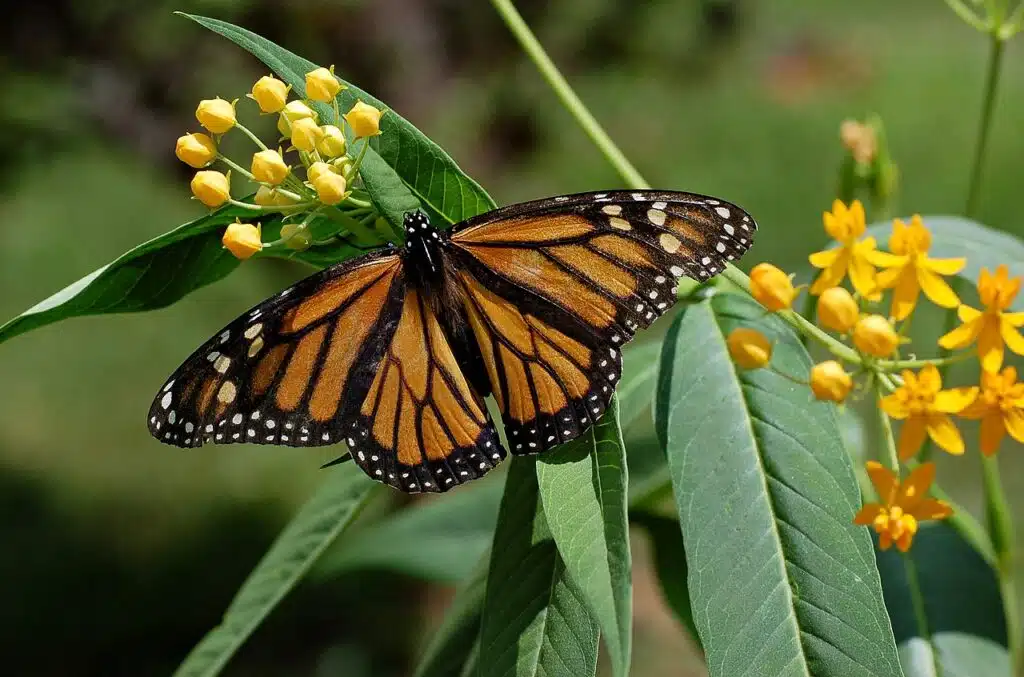
This orange butterfly (Danaus plexippus) is the most common in the state. Monarch butterflies are named after King William III of England also known as the King of Orange.
In Michigan, this butterfly species is mostly associated with host plants such as Showy milkweed.
The species is migratory, leaving the state just before winter to head South.
Monarch butterflies also mimic Viceroy butterflies to appear foul-tasting to their predators.
2. Red-spotted Admiral
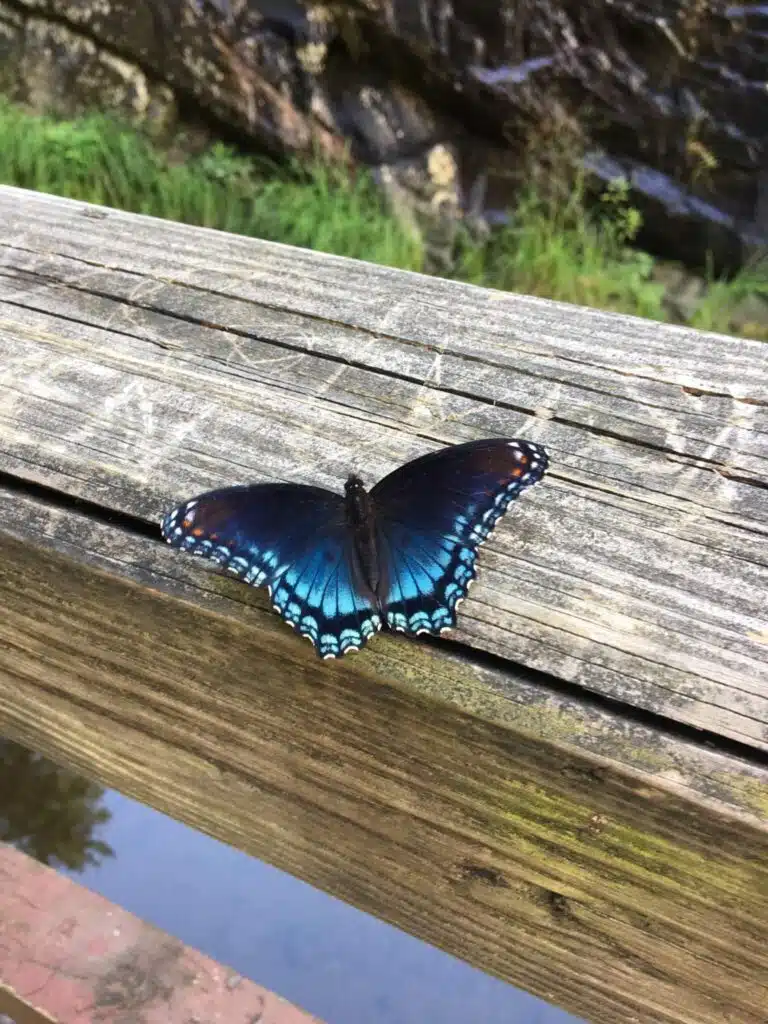
Red-spotted Admiral (Limenitis arthemis) is a very common sight across the state’s areas with plenty of willows.
Black cherry and sour cherry are also hosts of the species. Black cherry is a much more common host for Red-spotted Admirals in Southern states compared to sour cherry preferred in the North.
These butterflies have a wingspan of up to 3.5 inches and an identity characterized by black and blue coloring.
Dark blue to black colors are seen on the upper forewings while light blue is characteristic of its lower hindwings. Orange spots are also seen dorsally and ventrally.
3. Black Swallowtail
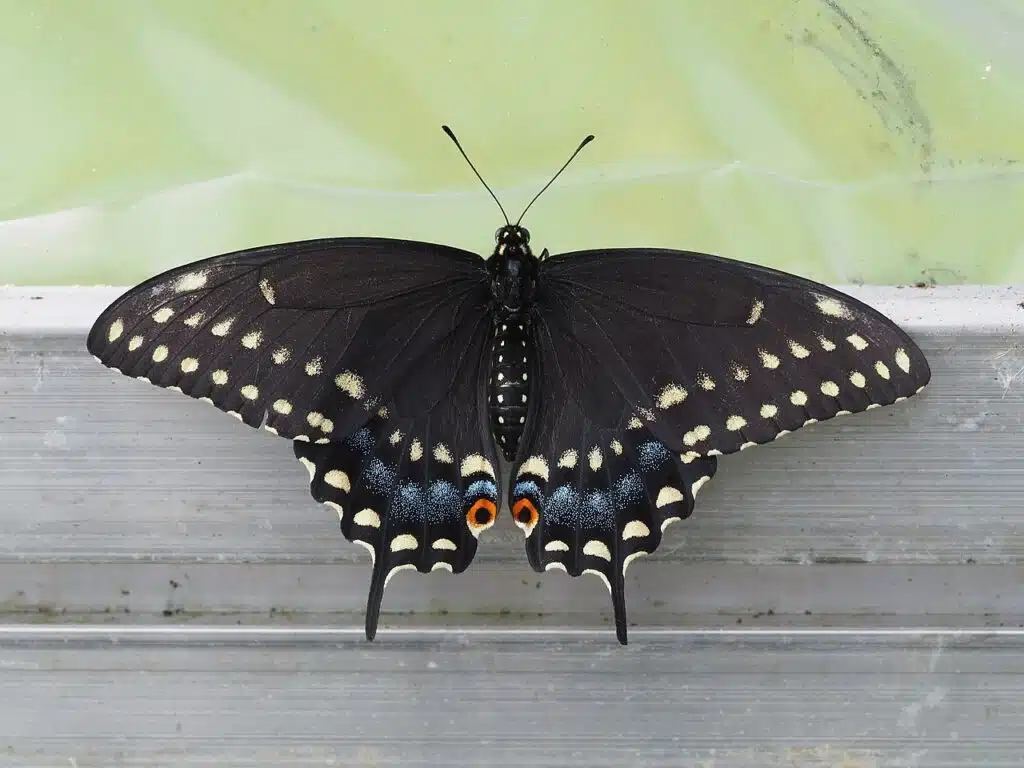
Black Swallowtails (Papilio polyxenes) are among the most common large butterflies in the state. This species has long black tails, black wings, and a black body.
Yellow, blue, and orange colored sections are further distinguished on the species.
Male Black Swallowtails are known for gathering in the same location for females to choose their prospective mates out of a large group in an elaborate mating ritual.
4. Cabbage White
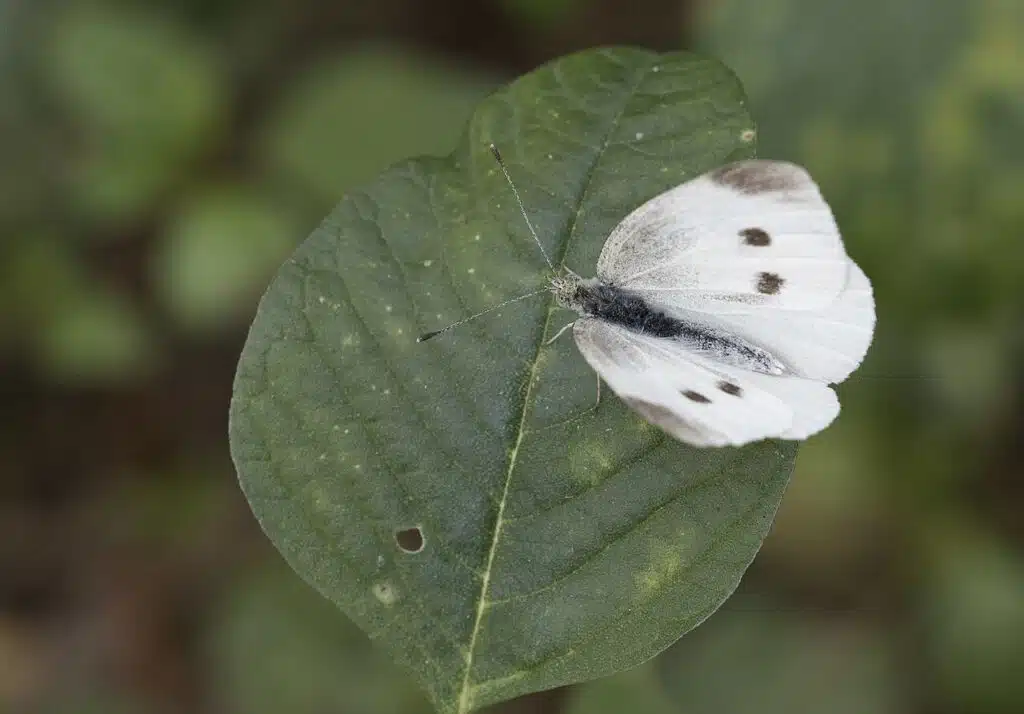
Cabbage White butterflies (Pieris rapae) resemble Large White species with an affinity towards cabbages and crucifers as hosts for their larvae.
You can find this species in urban areas across the state in small numbers and on crops and valleys in high numbers.
The base color of the species is white. Black is the secondary color present in different percentages of males and females.
The species is small as even the largest Cabbage Whites have a wingspan of up to 1.9 inches.
5. Eastern Tiger Swallowtail
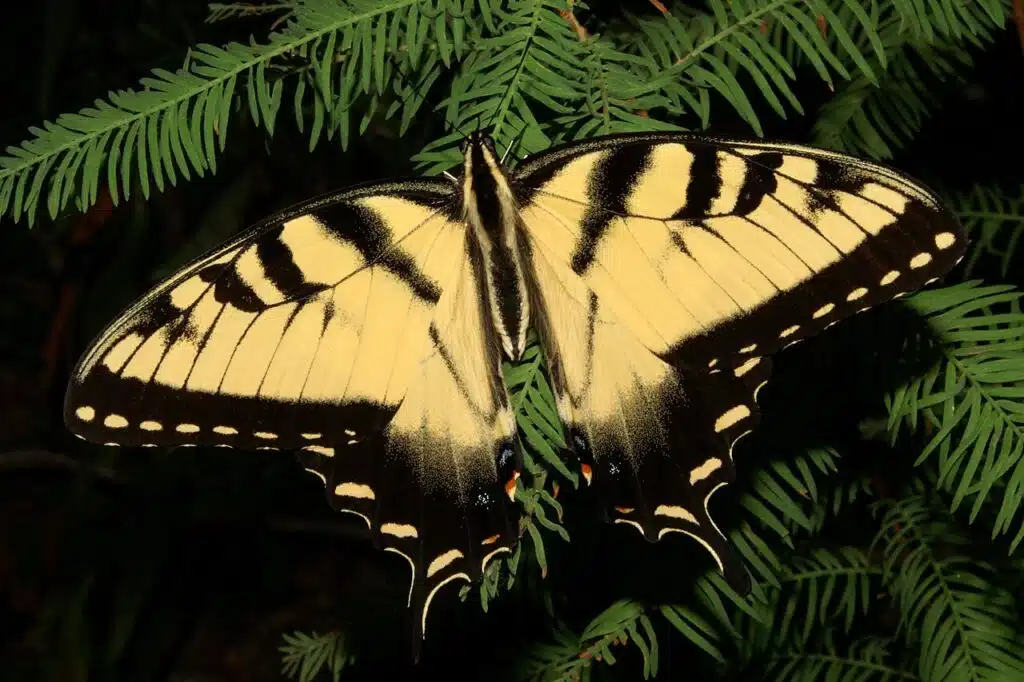
Eastern Tiger Swallowtails (Papilio glaucus) are known for their yellow and black coloring.
This species has a widespread presence across the United States and Michigan. It relies on flowers such as wild roses as hosts but it also uses trees as hosts.
From black cherry to cottonwood or even the common lilac, Eastern Tiger Swallowtails are seen on a wide range of hosts.
This species is also known for puddling, a process in which males feed on the nutrients in the mud together with other males.
6. Silver-spotted Skipper
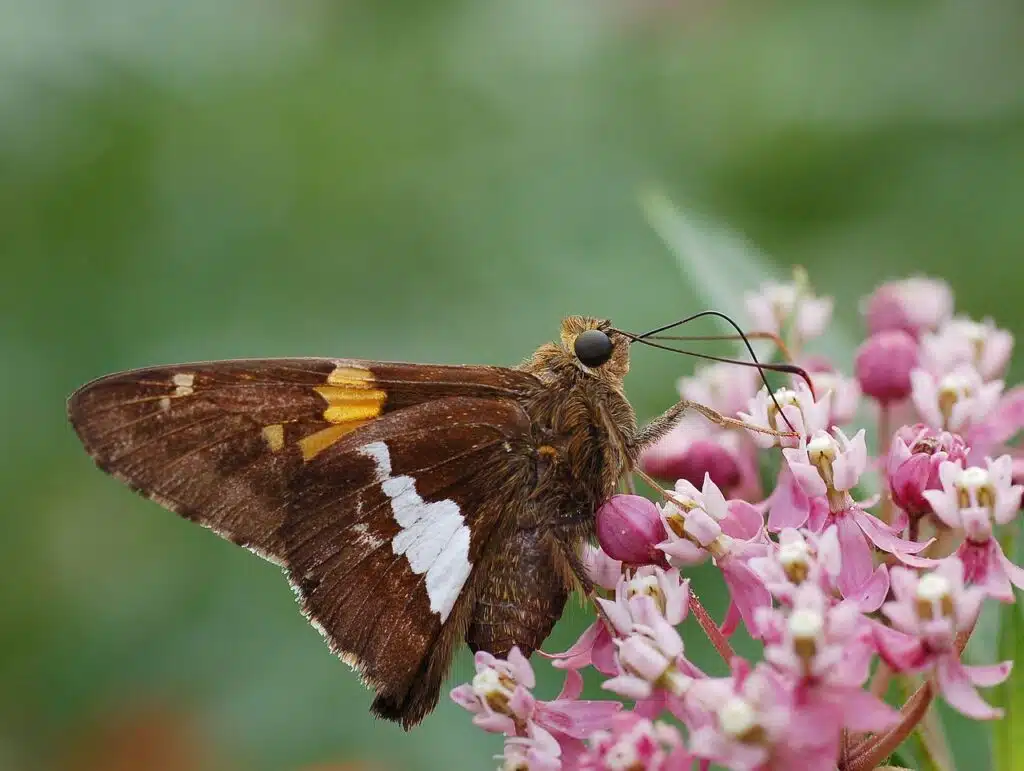
Silver-spotted Skippers (Epargyreus clarus) are the most common type of skipper butterflies in the state.
This species has dark brown coloring and green larvae. Most notably, the larvae of the Silver-spotted Skipper are known for wrapping themselves in a silk shelter around host plants.
This is a protective tactic meant to keep common predators away. Wasps are among the most notable Silver-spotted Skipper larvae predators.
7. Mourning Cloak
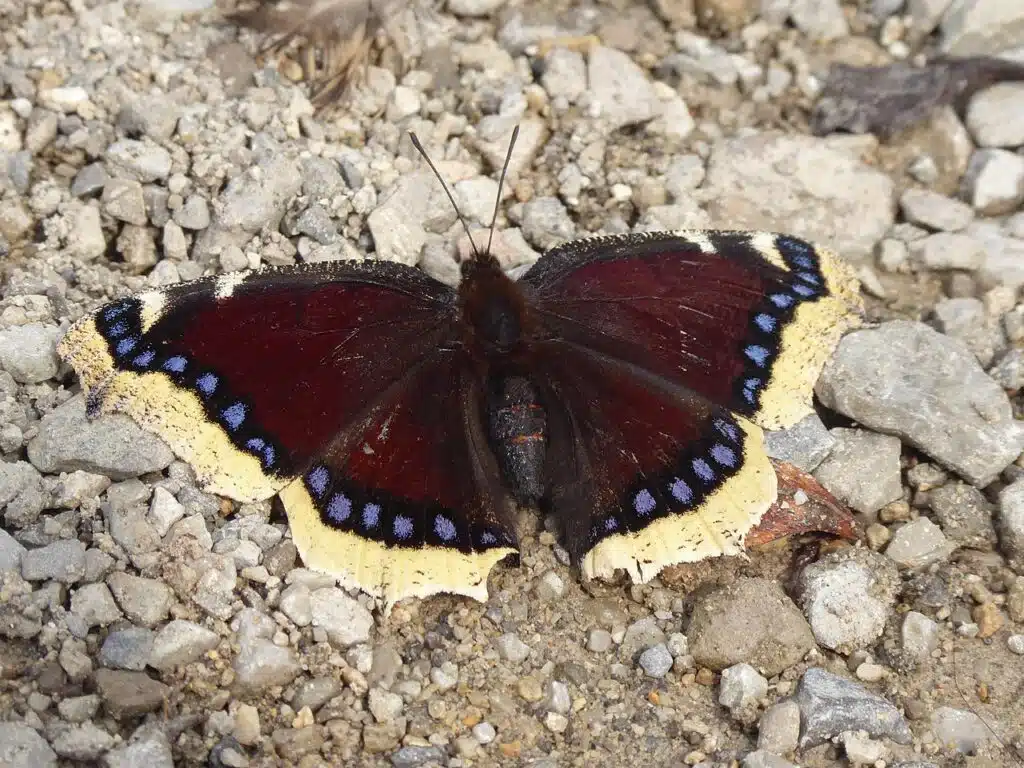
Mourning Cloak butterflies (Nymphalis antiopa) are common all across the Northern Hemisphere.
These butterflies are known for sitting on tree bark with their wings together to improve camouflage.
Their dorsal wings are characterized by brown, yellow, and blue colors.
Caterpillars of the species are known to have a long list of predators such as wasps and birds and are more exposed to predation compared to camouflaging adult Mourning Cloaks.
8. Red Admiral
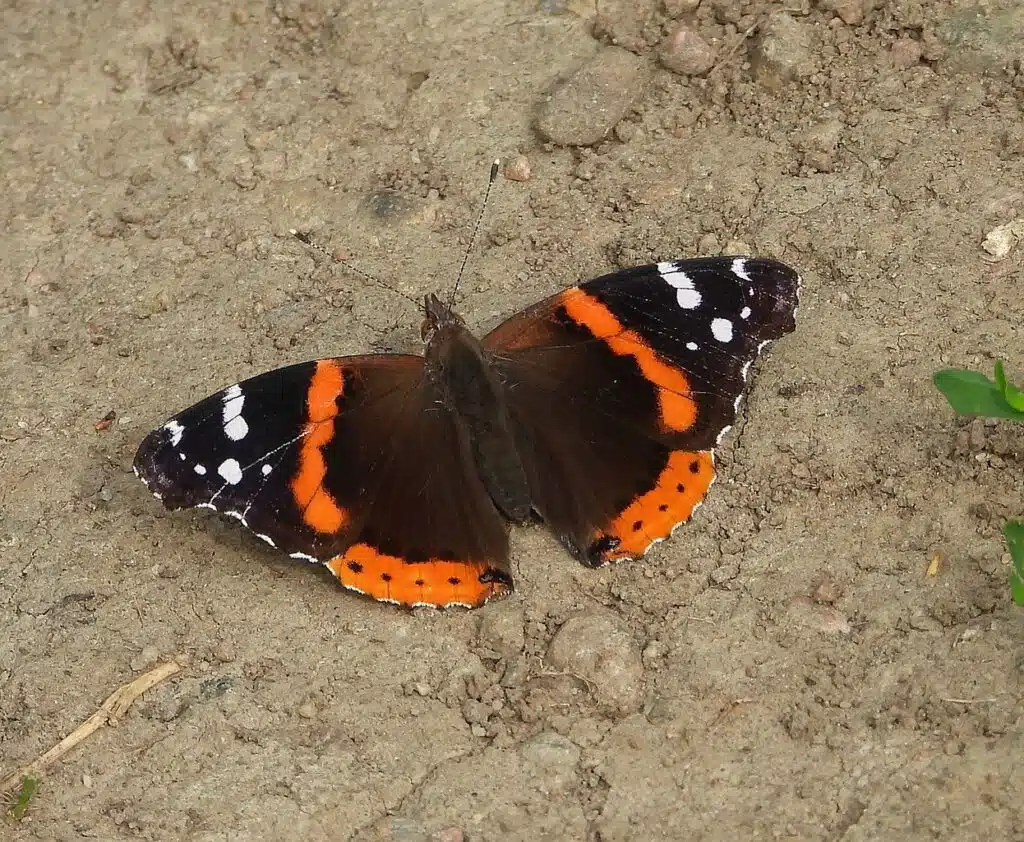
Red Admirals (Vanessa atalanta) are some of the most common butterflies in the state that have a wingspan of over 70mm.
These large butterflies have mostly black wings which make them stand out from other more colorful species.
The Red Admiral settled in North America from Europe. It’s a species known for migrating to Southern US states where it overwinters before heading back in the spring.
This species is mostly seen around stinging nettle.
Further Reading:
9. Spicebush Swallowtail
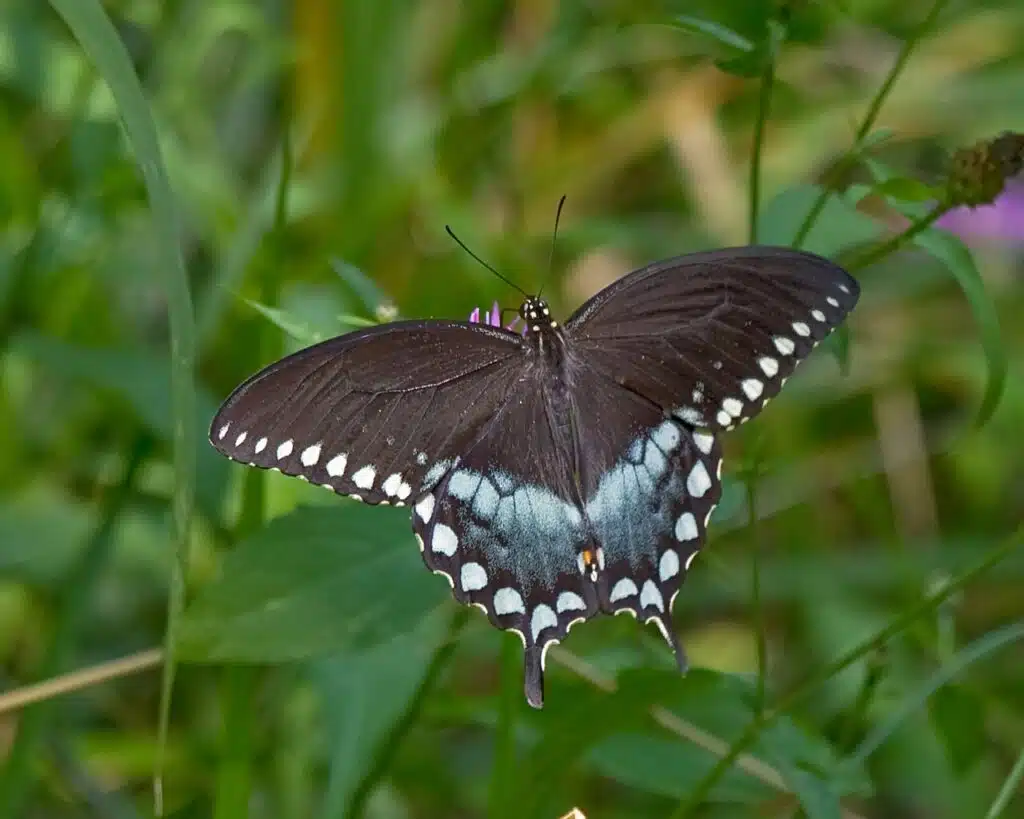
Similar to Red Admirals that have a preferred plant, Spicebush Swallowtails (Papilio troilus) prefer spicebush.
Lantana, thistles, and milkweed are among the most common plants that these butterflies are seen visiting for nectar.
Spicebush Swallowtails are also some of the largest butterflies in the state.
These butterflies are mostly black, with blue, orange, and white sections across their hindwings.
Contrasting white dots are seen on the margins of the wings.
10. Peck’s Skipper
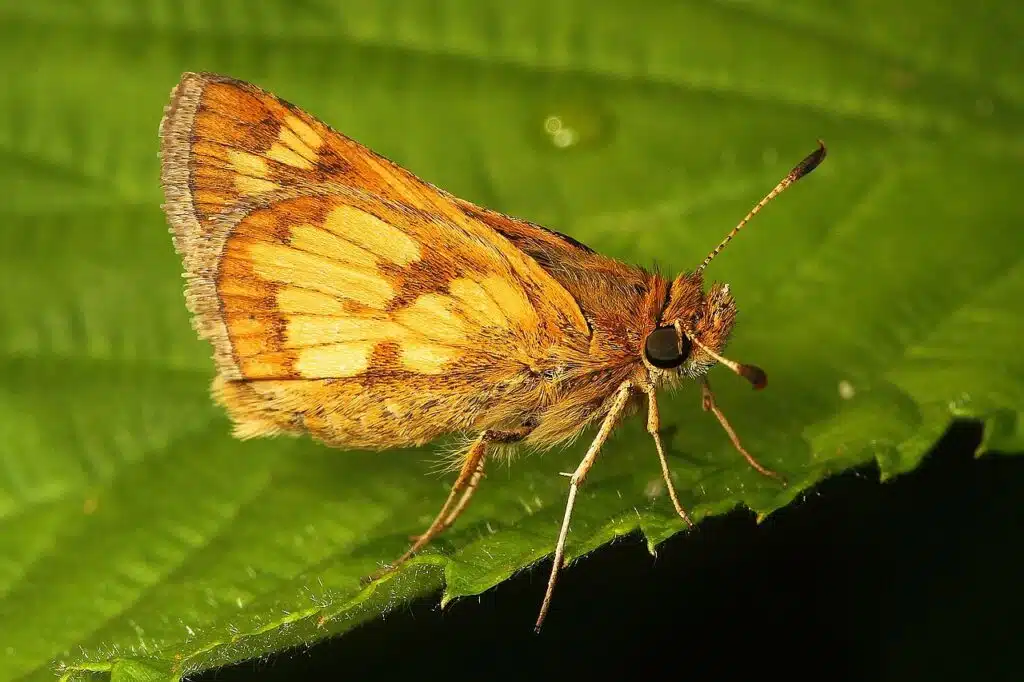
Peck’s Skippers (Polites peckius) are one of the many grass butterflies in the state. You can see these butterflies on meadows and even along roads.
Adult Peck’s Skippers feed on clover nectar with additional preferences including thistles.
You can identify these butterflies by the V-shape of their folded forewings, as with many other skippers.
At least 2 broods of Peck’s Skippers are seen per year.
11. Pearl Crescent
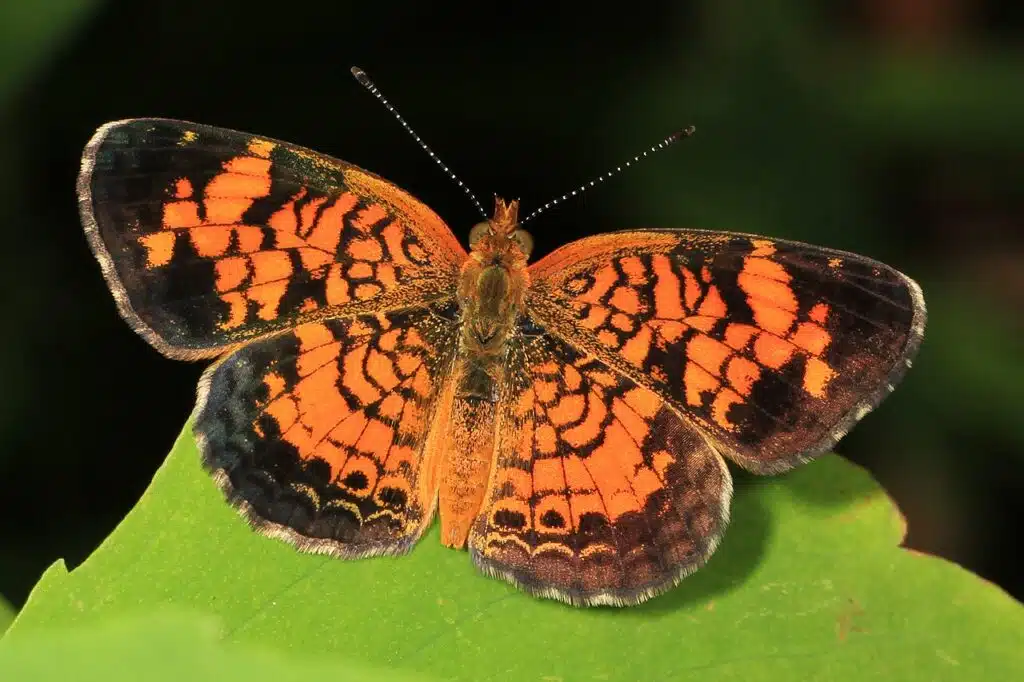
Pearl Crescents (Phyciodes tharos) are some of the smallest orange butterflies in Michigan.
They have varying wingspans that can measure anywhere between 20 and 34mm. The wings are mostly orange.
Black patterns cover a large section of the wings while white dots are seen right on the edges of the wings.
You can find Pearl Crescents are most active until November in the state. Their season is tied to the availability of asters.
12. Northern Crescent
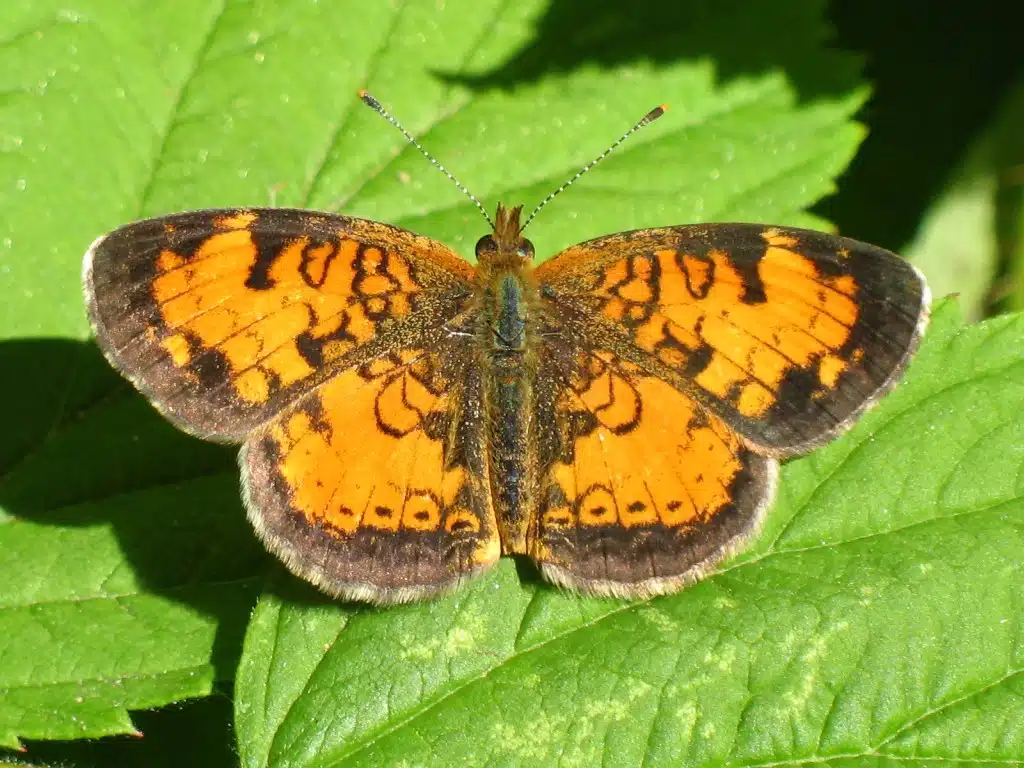
Northern Crescents (Phyciodes cocyta) resemble Pearl Crescent butterflies in coloring and size.
These butterflies also have orange and black coloring. Their forewings and hindwings are orange with black margins and black patterns across.
The species grows to a size of up to 38mm being one of the smaller butterflies in the state.
Most Northern Crescents are seen on asters on meadows and next to woodlands as host species.
Adult Northern Crescents feed on dogbane nectar.
13. Great Spangled Fritillary
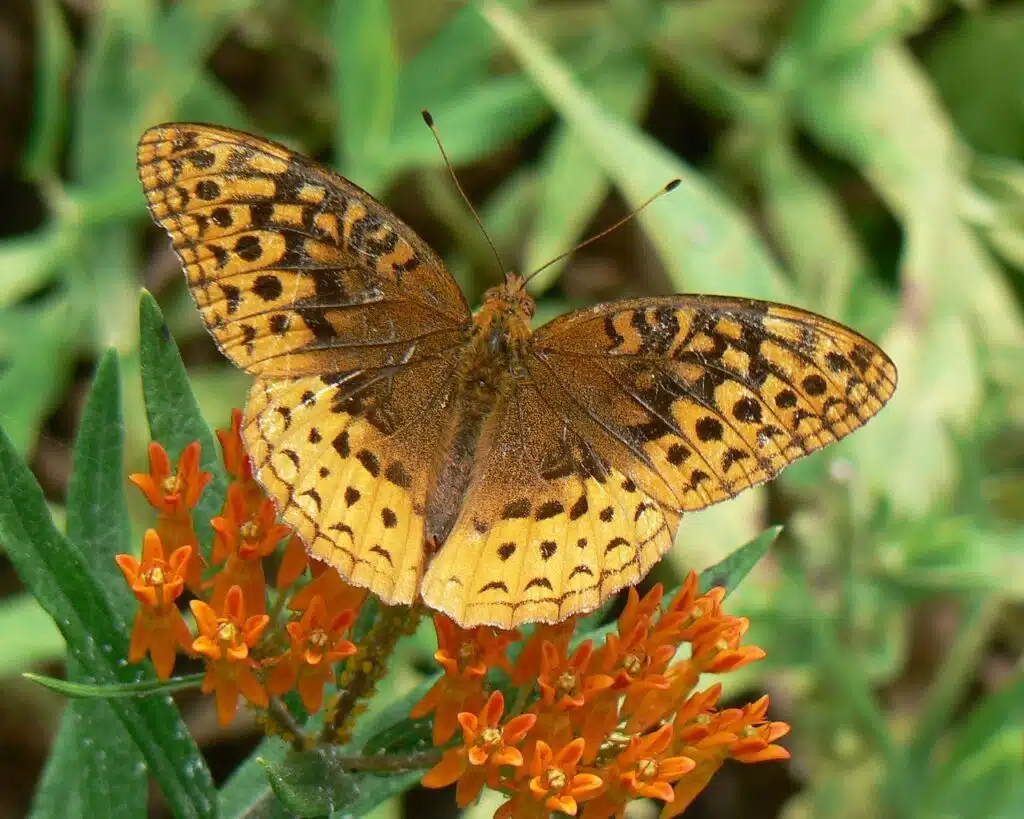
Brown and yellow colors are specific to Great Spangled Fritillary (Speyeria cybele).
These butterflies have brown upper wings and yellow hindwings.
Black patterns decorate the entire surface of the wings.
This species has similar coloring on its ventral side. Light brown colors with multiple large white spots are characteristic of its ventral wings.
Great Spangled Fritillary butterflies have a medium to large size with a maximum wingspan of up to 88mm.
14. Northern Pearly-Eye
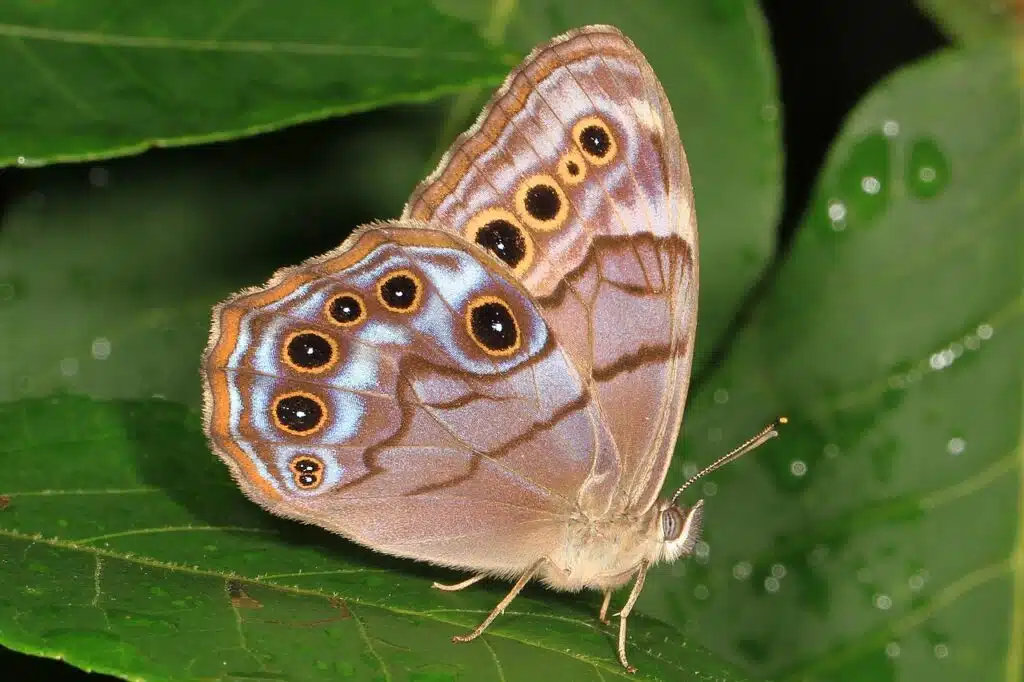
Northern Pearly-Eye butterflies (Lethe anthedon) are among the species seen on lawns, gardens, and parks of the state.
This species is interested in using various types of grass as host plants. Its caterpillars feed on these grasses.
Bearded shortgrass is among the most common host grasses of the species.
Northern Pearly-Eye butterflies have a dark brown color with multiple black eyespots.
The species is dominated by both dorsal and ventral eyespots.
15. Viceroy
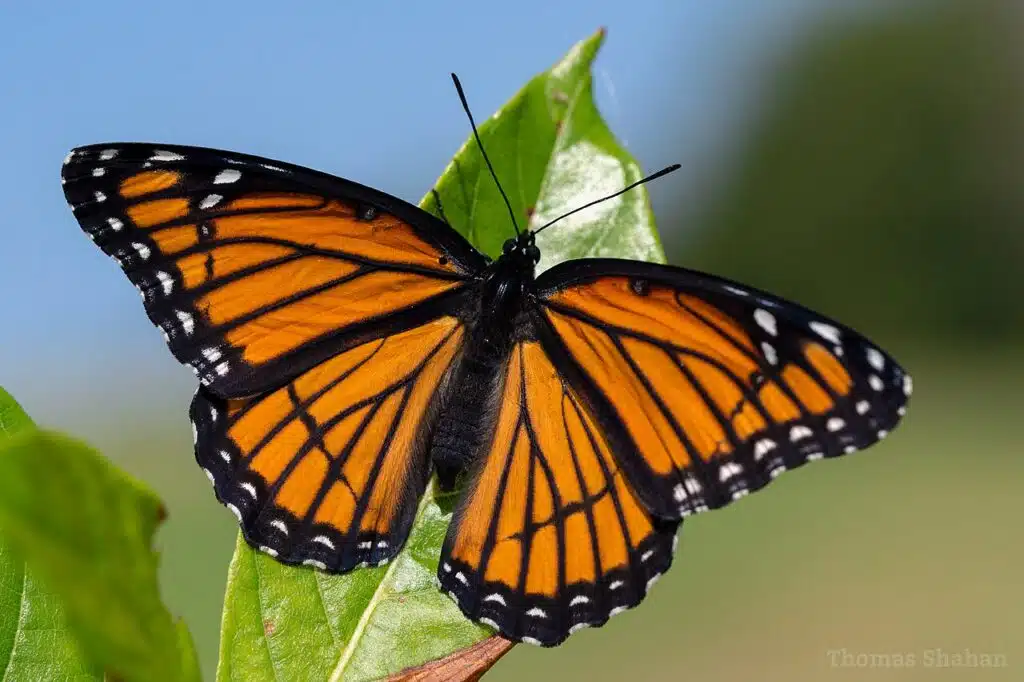
Viceroy butterflies (Limenitis archippus) are some of the most confusing species in the state due to their resemblance to Monarchs.
This species also has mostly orange coloring with black veins and black margins.
It’s a species that mimics other butterflies that taste bad for predators.
You can see Viceroy butterflies during the day as they represent a diurnal species. However, they prefer mornings for food and mating.
16. Eastern Giant Swallowtail
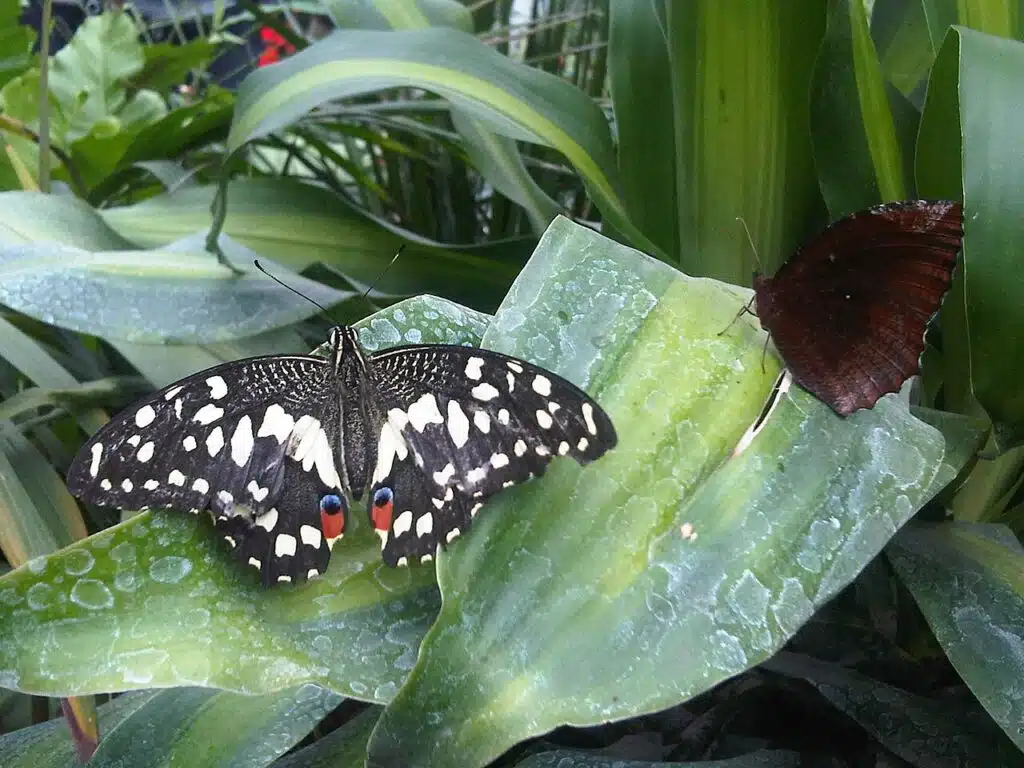
Eastern Giant Swallowtails (Papilio responses) are a pest of citruses. The caterpillar of the species is also seen as a pest on many other crops.
Eastern Giant Swallowtail butterflies are some of the largest black species in the state.
They have black forewings and black hindwings.
Yellow coloring contrasts with the black wings of the species. A horizontal yellow band and yellow wing margins are seen on this species.
17. Little Wood Satyr
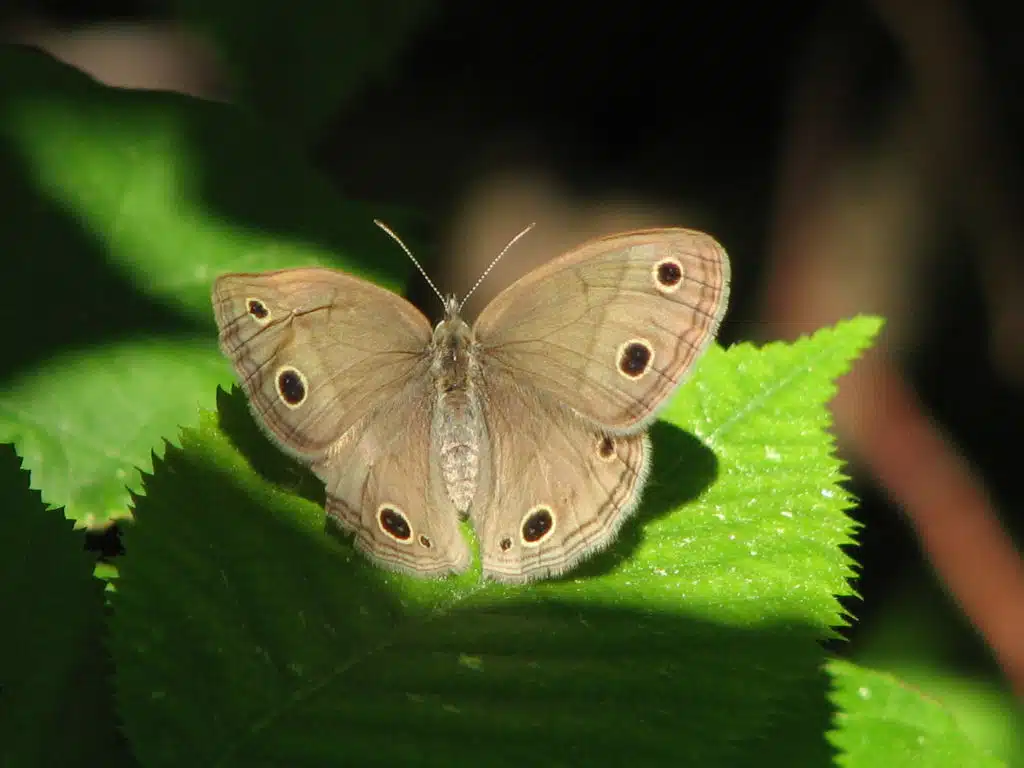
Adapted to the climates of Michigan, Little Wood Satyr butterflies (Megisto cymela) are identified by their rare shade of brown.
The main color of the species is brown but the nuance is close to gray.
Butterflies of this species are also known for having large brown eyespots that make them visible from a long distance. Its ventral wings also have dark brown eyespots.
The species is small but can sometimes be seen as a medium-sized butterfly, especially in the case of larger individuals with wingspans close to 50mm.
18. Baltimore Checkerspot
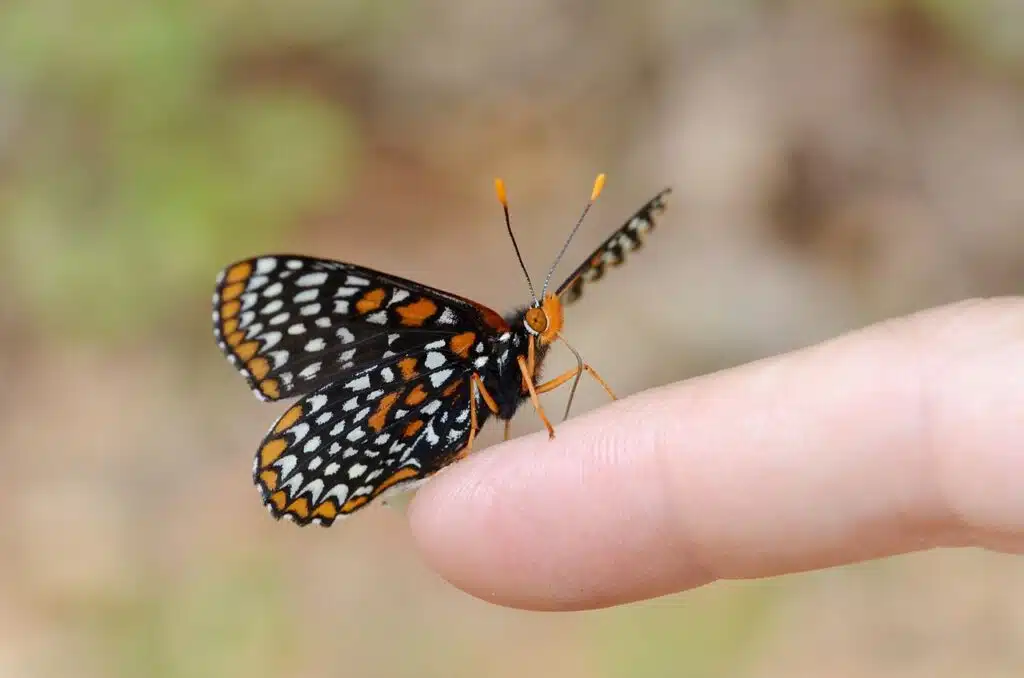
This colorful species (Euphydryas phaeton) is mostly seen around host white turtle heads.
You can identify this species by its brown, white, and orange coloring.
Brown is the base color of the species with white and orange dots across the outer margins of the forewings and hindwings.
Baltimore Checkerspot butterflies are active in the summer and are seen on the left as orange caterpillars with black spots and lines.
This species can overwinter under dead grass and leaves.
19. Common Wood-Nymph
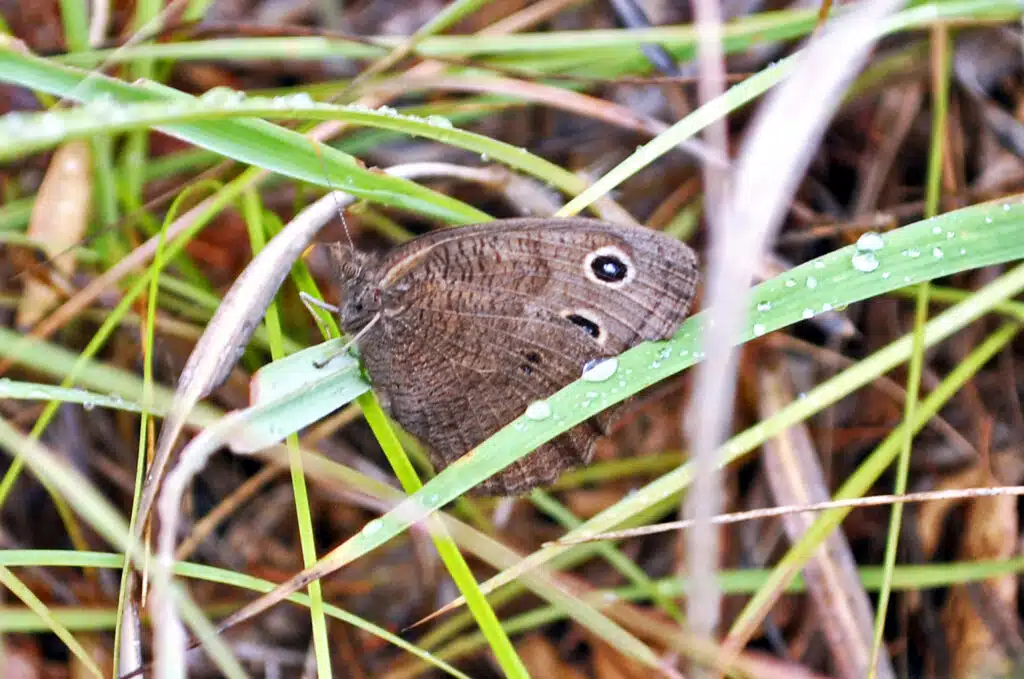
Common Wood-Nymph butterflies (Cercyonis pegala) are seen along woodlands in the state.
It can be found just on the edges of woodlands and its coloring reflects its habitat.
Both its dorsal and ventral colors are dominated by brown base colors.
The dorsal coloring of the species is dark brown. Light brown patches with 2 dark brown eyespots are seen on its forewings.
Common Wood-Nymph butterflies have light brown ventral wings with 2 more eyespots that have white central areas.
20. Eastern Comma
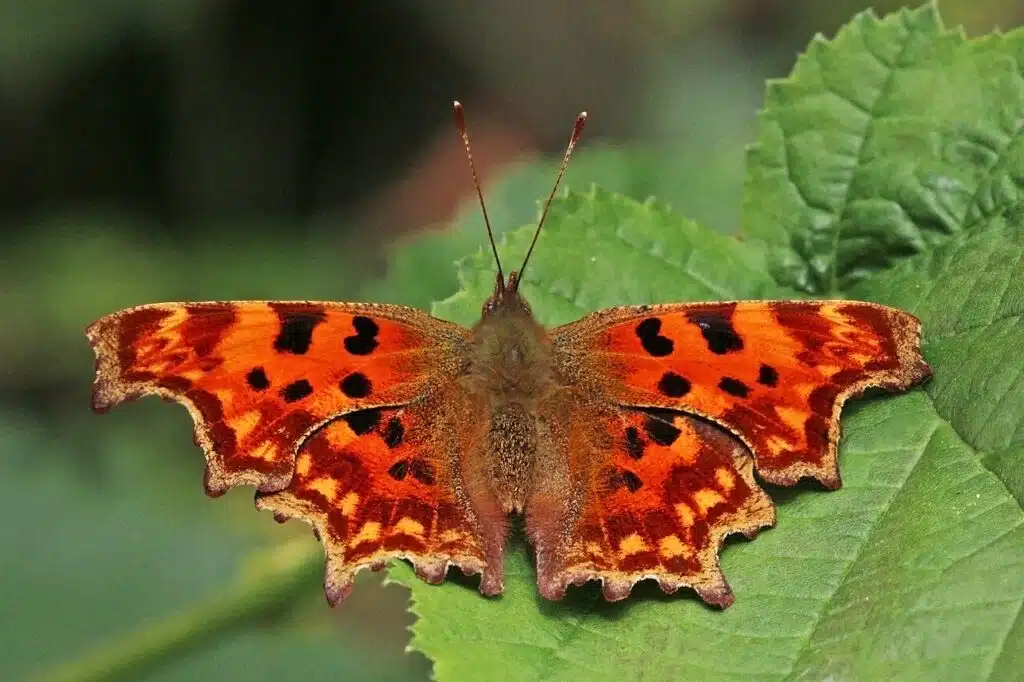
Eastern Comma butterflies (Polygonia comma) have yellow-orange and brown coloring. These butterflies are known for having lighter colors on the forewings with black or dark brown spots.
The body of the species has gray-brown coloring.
Eastern Comma butterflies are very specific when it comes to hosting plants. Adults rely on nettles while caterpillars are seen on some of the most common trees in the state such as the American Elm.
21. Painted Lady
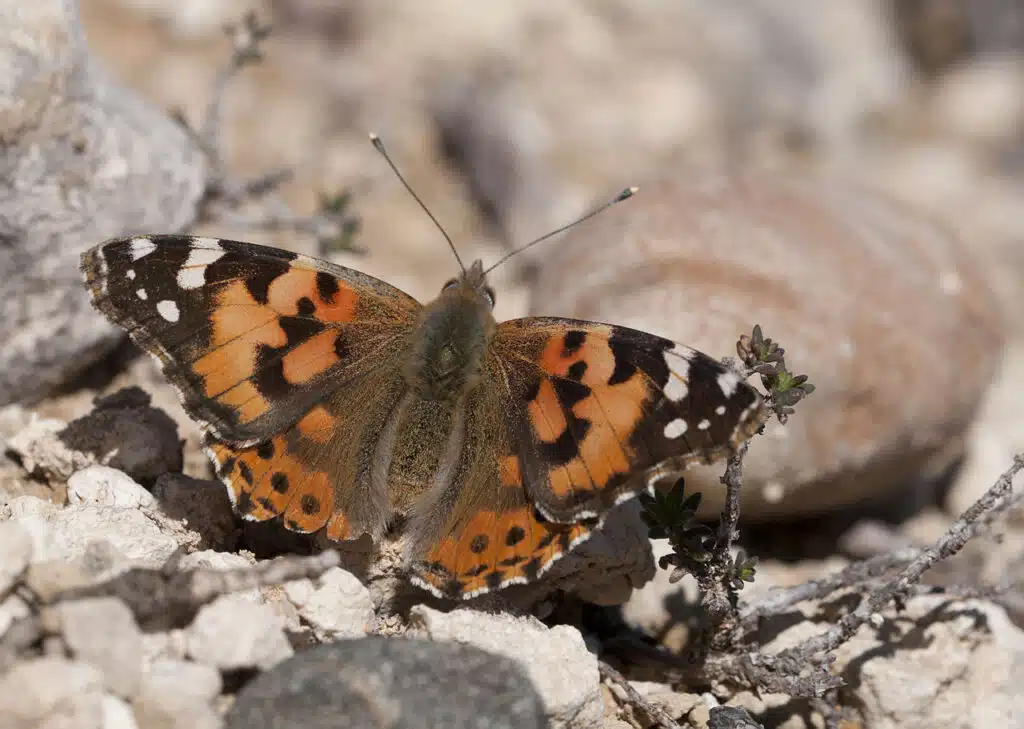
Various species of asters are the main nectar sources for these butterflies (Vanessa cardui).
They are a migratory species that prefers to move South soon after the summer months.
Painted Lady butterflies are identified after the base orange color with black forewings that feature white spots.
The body of the species has a light brown color that’s similar to the light brown base color of its ventral wings.
Eyespots are also visible on their wings, but only on their ventral side.
22. Canadian Tiger Swallowtail
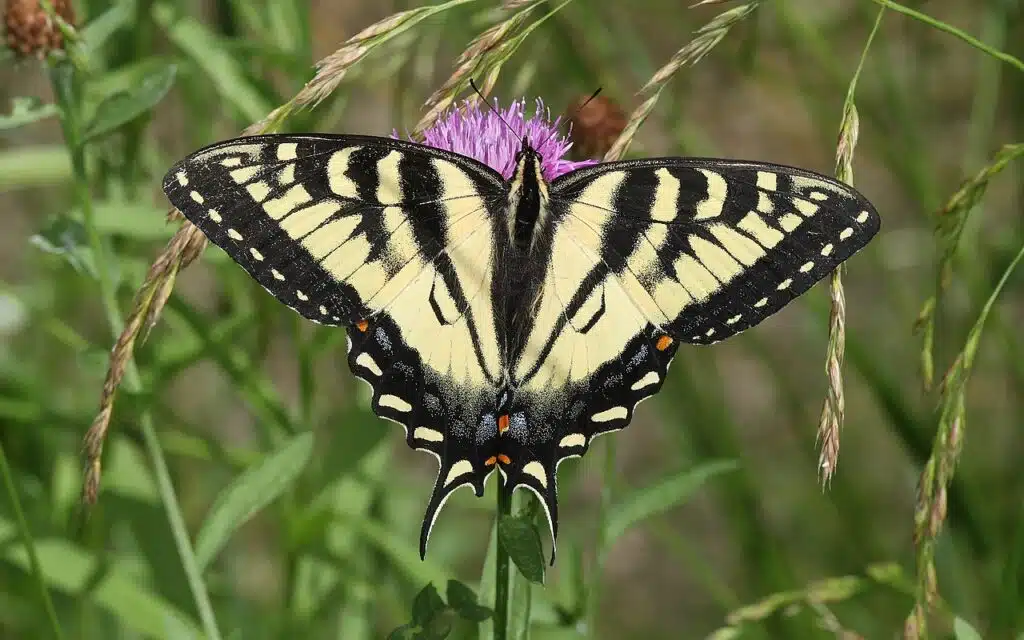
Canadian Tiger Swallowtails (Papilio canadensis) are present across Michigan.
This species only has one brood per year but it makes its way into some of the Northern US states from Canada during the summer.
You can identify the species by its yellow and black colors.
Yellow is dominant while black is seen on the margins of its wings.
This species is also among the butterflies with tails in the state. 2 short black tails are seen on the lower part of its hindwings.
23. American Lady
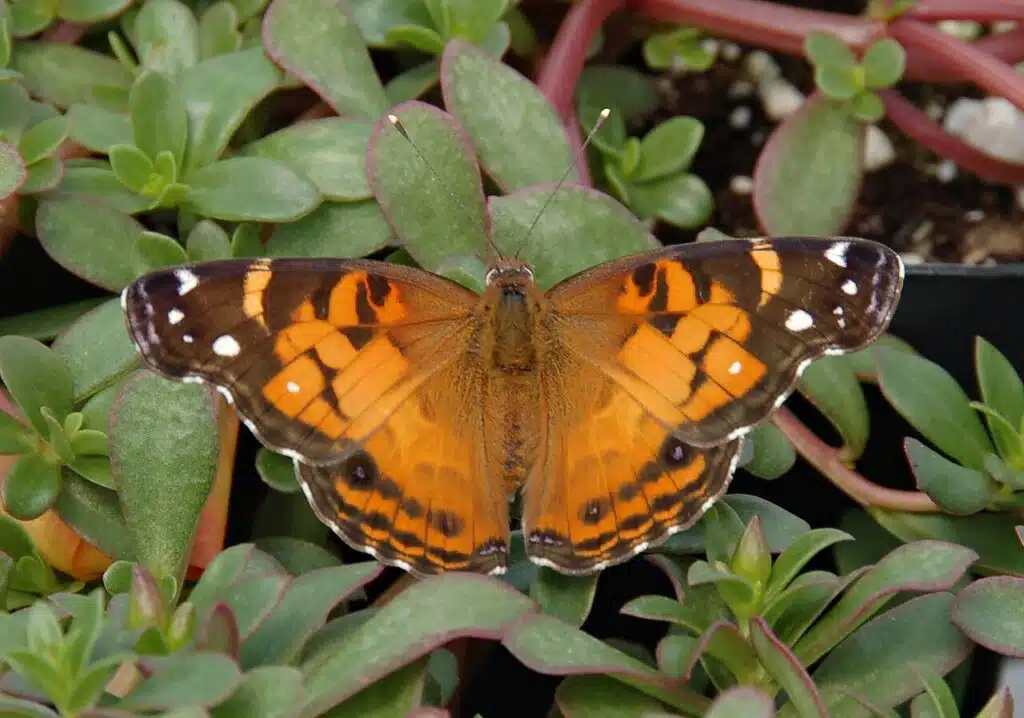
American Lady butterflies (Vanessa virginiensis) look similar to Painted Lady species.
Orange wings with black sections and white marks characterize the ventral colors of these butterflies.
American Lady butterflies have brown-gray ventral wings. Large blue eyespots are seen in its ventral wings.
Eyespots have the role of diverting predators to attack less important areas of the species to increase their survival chances in case of an attack.
24. Essex Skipper
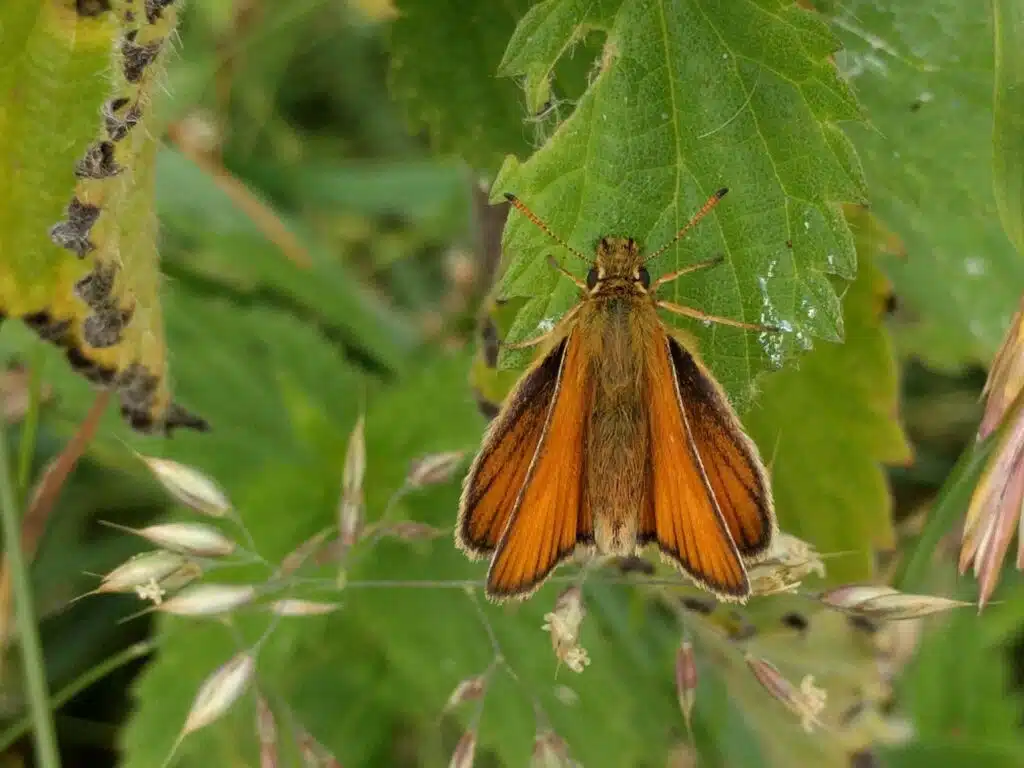
Essex Skippers (Thymelicus lineola) have dark colors such as many other skippers in the state.
Dark orange or dark brown colors cover the entire surface of the wings except the dark brown to black margins and dark brown to black margins.
This species has muted gray-brown coloring across its ventral wings.
Butterflies of this genus have V-shaped foldable forewings.
Female Essex Skippers lay green-yellow eggs on green plants.
25. Compton Tortoiseshell
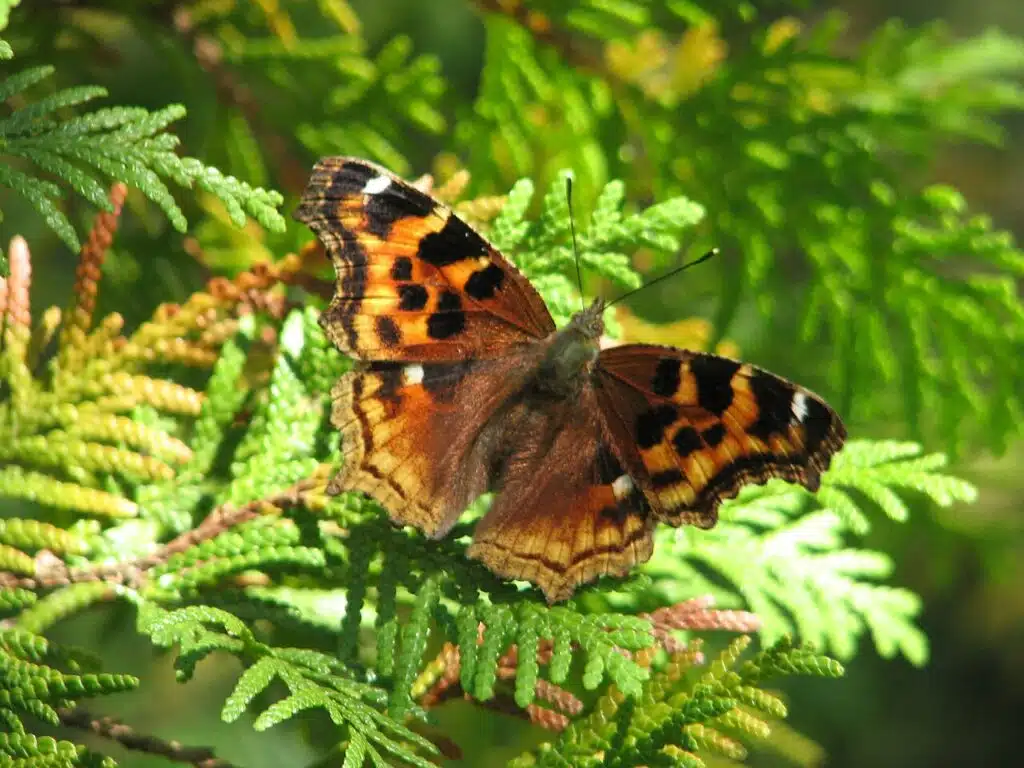
Compton Tortoiseshell butterflies (Nymphalis l-album) are most likely to be seen in riparian areas in the state.
These butterflies are seen on aspen but are more common on willows.
Both caterpillars and adults use willows as host species or for nectar.
Adults are also known for eating plant sap.
On occasion, Compton Tortoiseshell butterflies can also eat fruit.
26. Clouded Sulphur
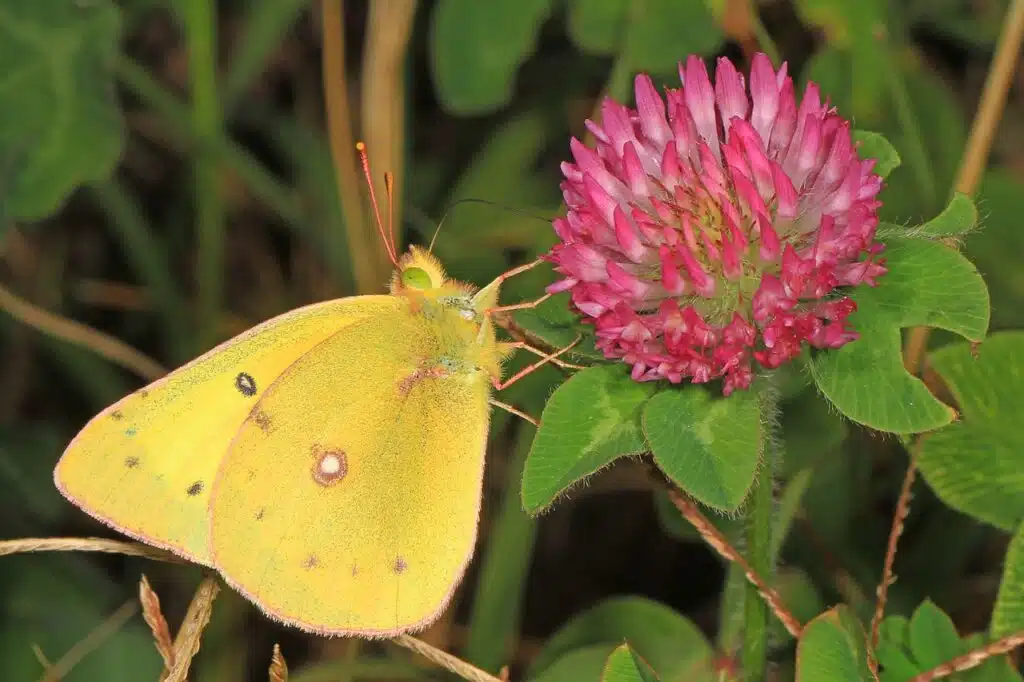
Clouded Sulphurs (Colias philodice) feed on various plants. Some of these plants are legumes which makes the species a common pest.
These butterflies come in different colors. From yellow to light green, they are seen in different nuances.
A rare female Clouded Sulphur morph is even white.
You can see the caterpillars of the species on white plum.
27. Hobomok Skipper
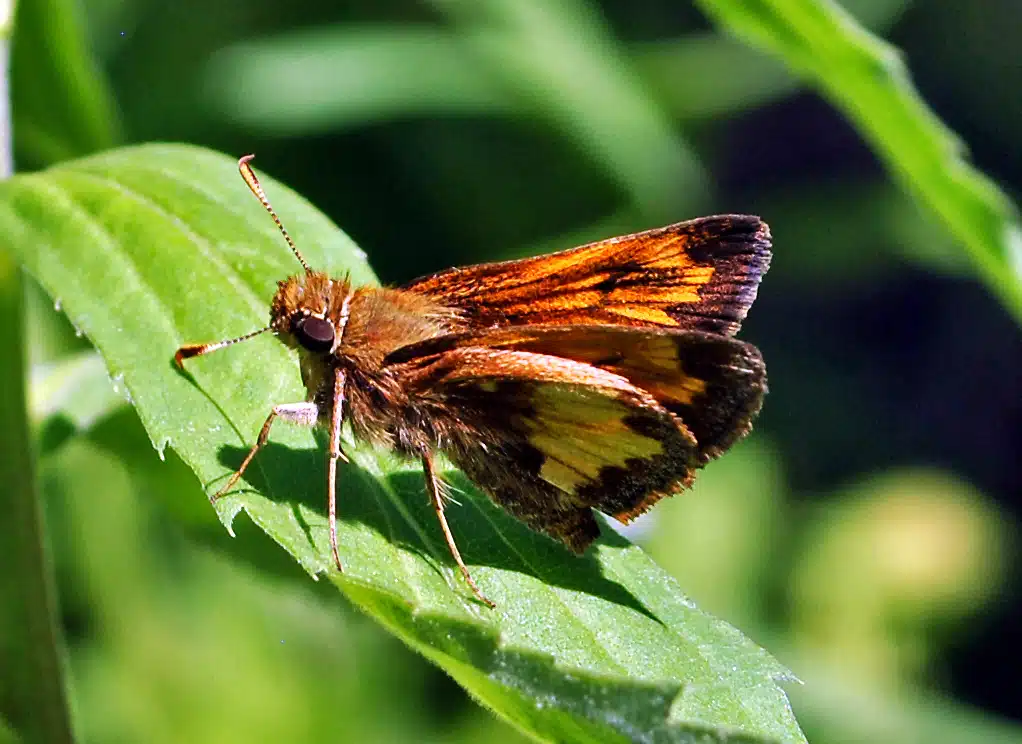
Hobomok Skippers (Lon hobomok) are part of the Hesperiidae family.
They are often confused with other skippers in the state given they are also yellow and brown.
This species has upward-facing forewings which characterize skippers.
You can find Hobomok Skippers near woodlands across the state.
28. Eastern Tailed-Blue
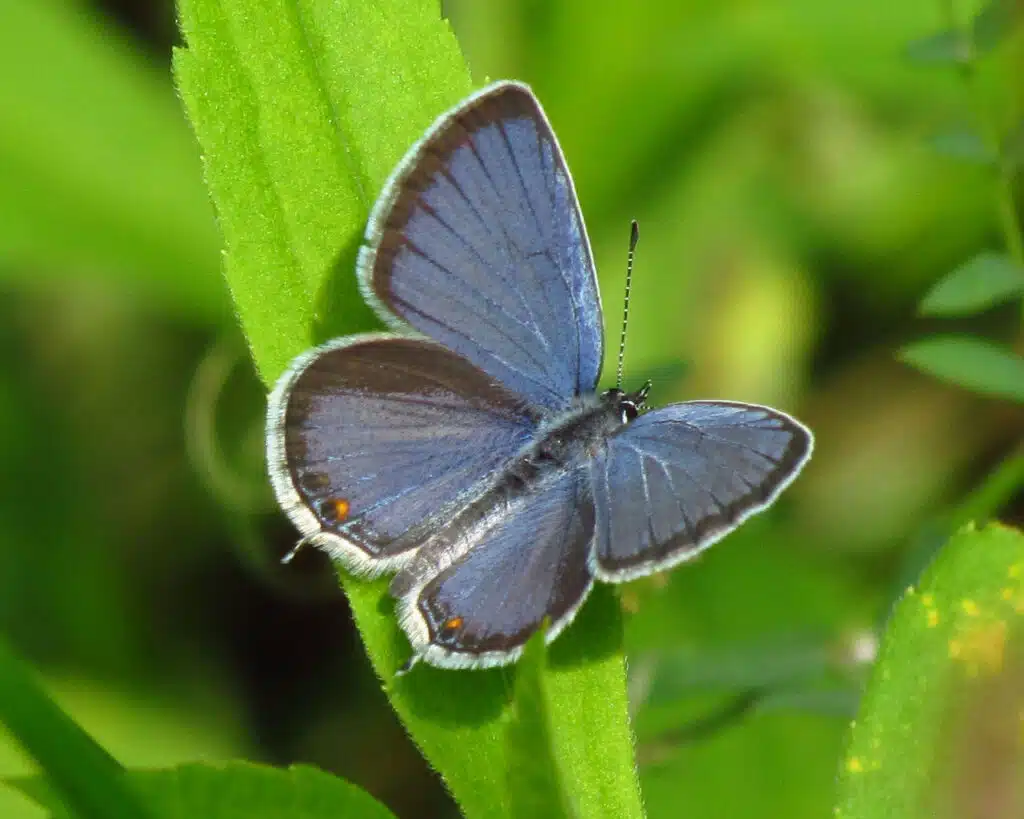
Seeing Eastern Tailed-Blue butterflies (Cupido comyntas) isn’t a good sign as the species is a known pest on crops and in gardens.
These dark-colored species are known to eat the leaves of various vegetables.
On occasions, Eastern Tailed-Blue butterflies have also been spotted eating small plant and legume seeds.
29. Small Copper
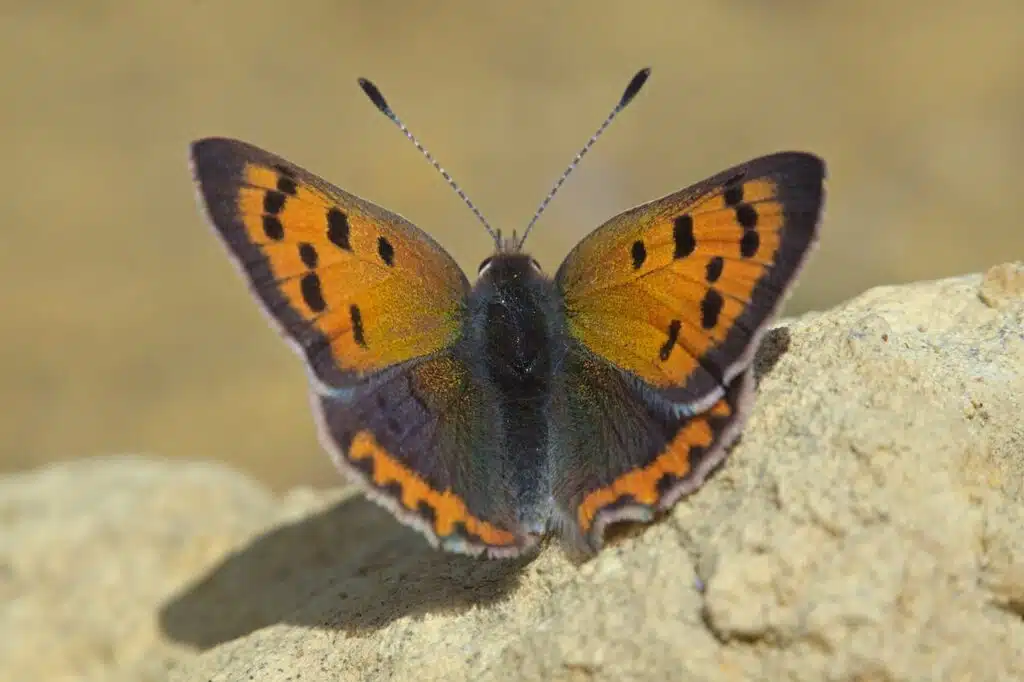
Small Cooper butterflies (Lycaena phlaeas) prefer sunny areas and they can be found next to woodlands or in woodland clearings.
Orange color is specific to its forewings while its hindwings are mostly dark brown.
Brown spots are further seen on the orange sections of its wings. Sorrel plants are among its preferred hosts.
30. Banded Hairstreak
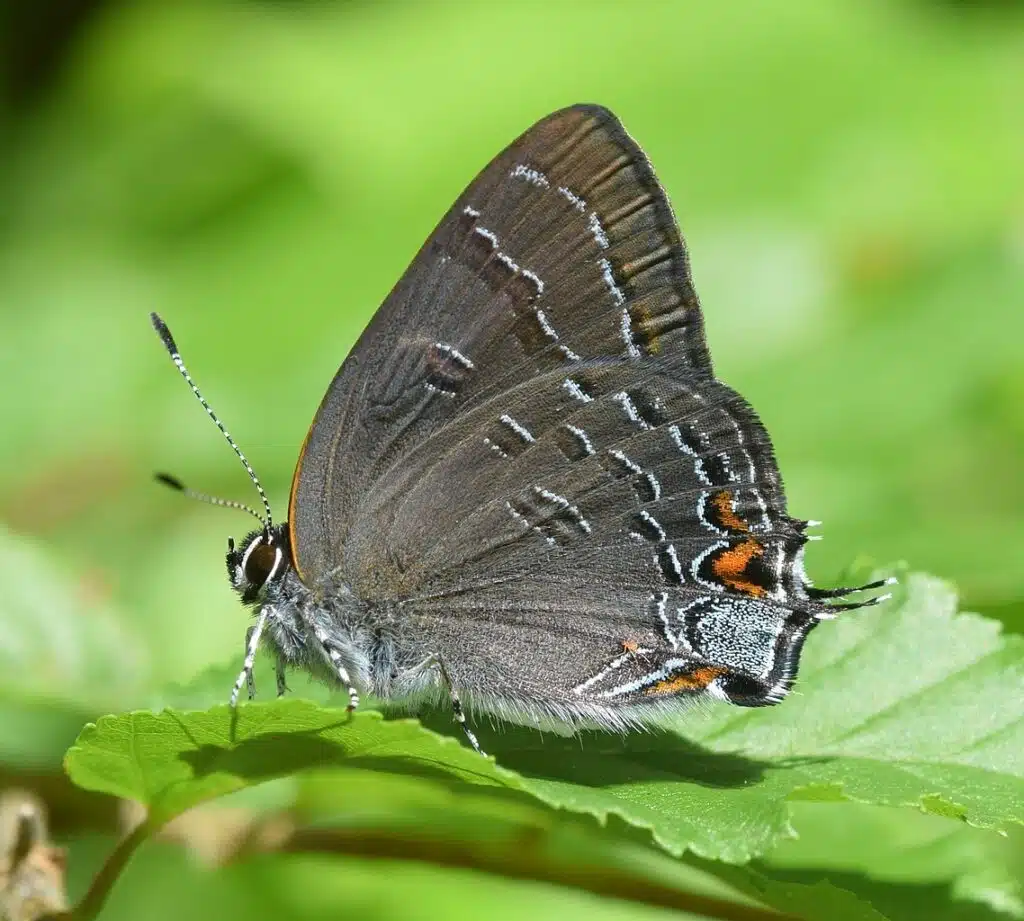
This species of butterflies (Satyrium calanus) use mimicry coloring to avoid predation. It has gray-brown ventral wings which mimic the color of tree bark to escape predation.
Banded Hairstreaks are among the species that feed on tree leaves, but without a considerable negative impact.
Some of the preferred trees include hardwood trees such as oak and hickory.
31. Question Mark
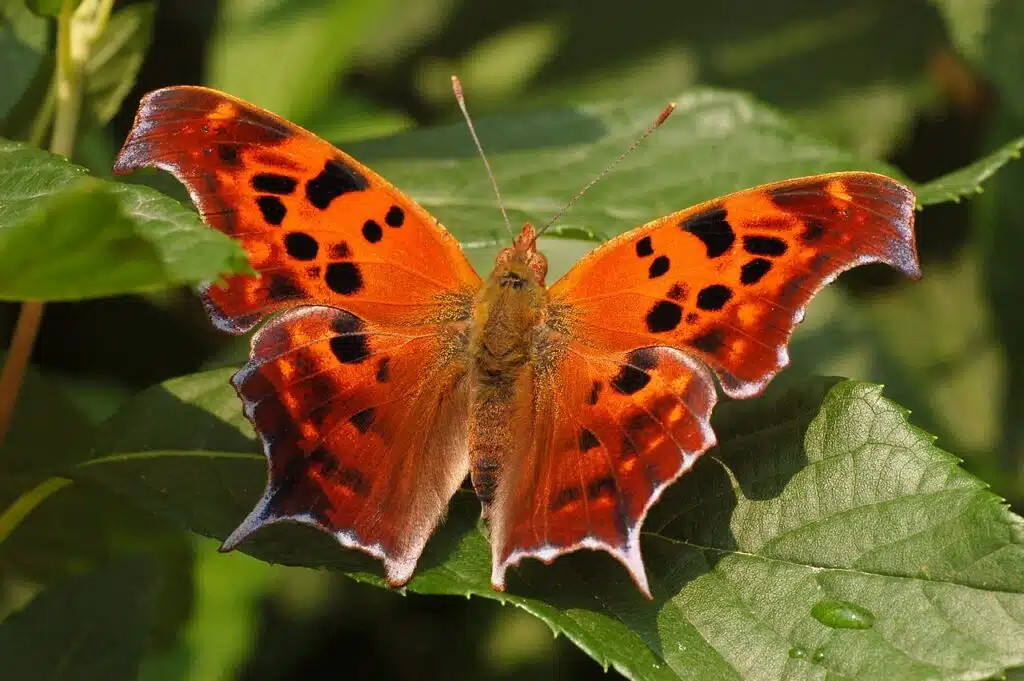
Question Mark butterflies (Polygonia interrogationis) aren’t detrimental to trees even if they are known for eating tree sap.
This species of butterflies prefer decaying or rotting food.
Carrion is among its favorite food sources. Various small rotting fruits are also eaten by this species.
Question Mark butterflies grow to a wingspan of up to 3 inches.
32. Least Skipper
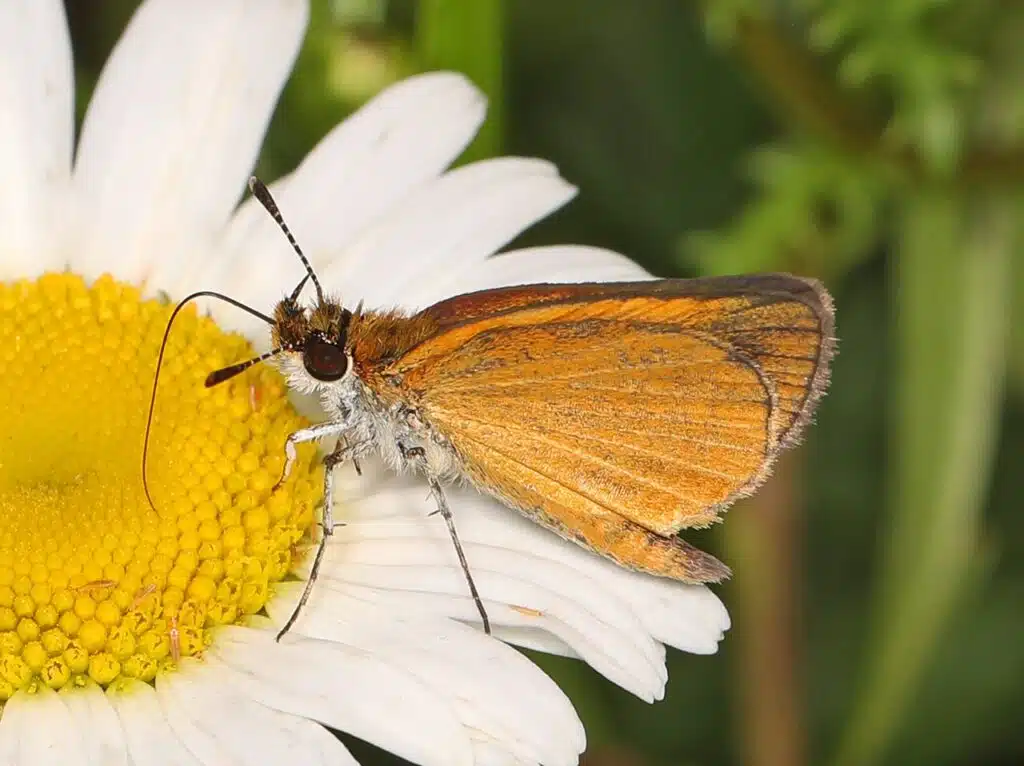
Least Skippers (Ancyloxypha numitor) are among the few species that prefer humid habitats within the state.
You can find Least Skippers in humid areas with tall grass.
This species has a season that begins in May and ends in September.
Its flight season is different from the flight season of Least Skipper in warmer climates where the butterfly can be active until December.
33. Appalachian Brown
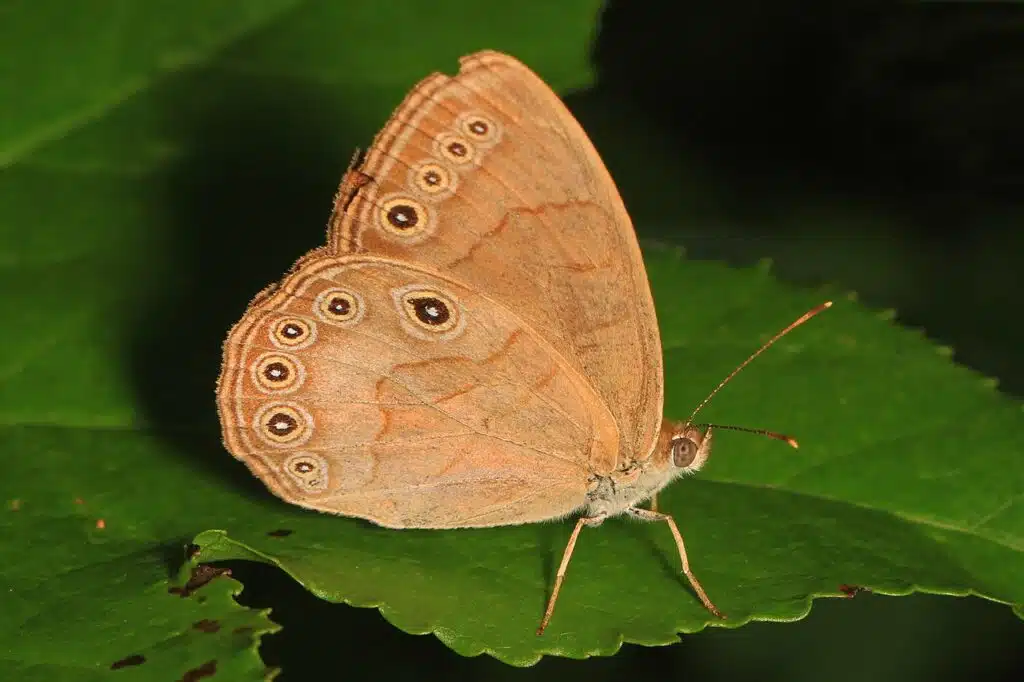
This species of butterfly (Lethe appalachia) is known for having the most eyespots.
It has 10 ventral eyespots which are dark brown with yellow and black margins. White central points are characteristic of these contrasting eyespots.
Dark brown is the main color of the dorsal wings while light brown-gray is specific to the ventral wings.
34. Common Checkered-Skipper
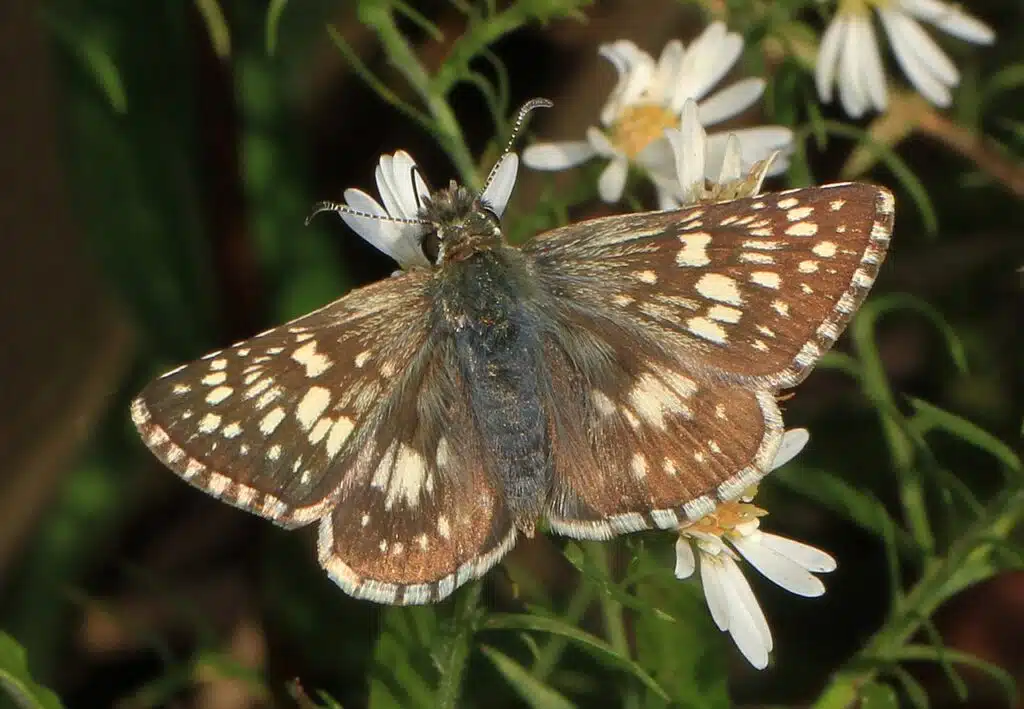
This species (Burnsius communis) is seen across open fields, valleys, and meadows in the state.
It has a checkerboard pattern across its wings that inspire its name.
Gray to blue hairs is seen along its body.
The butterfly is a small species with a wingspan that can be as short as 19mm.
35. Common Buckeye
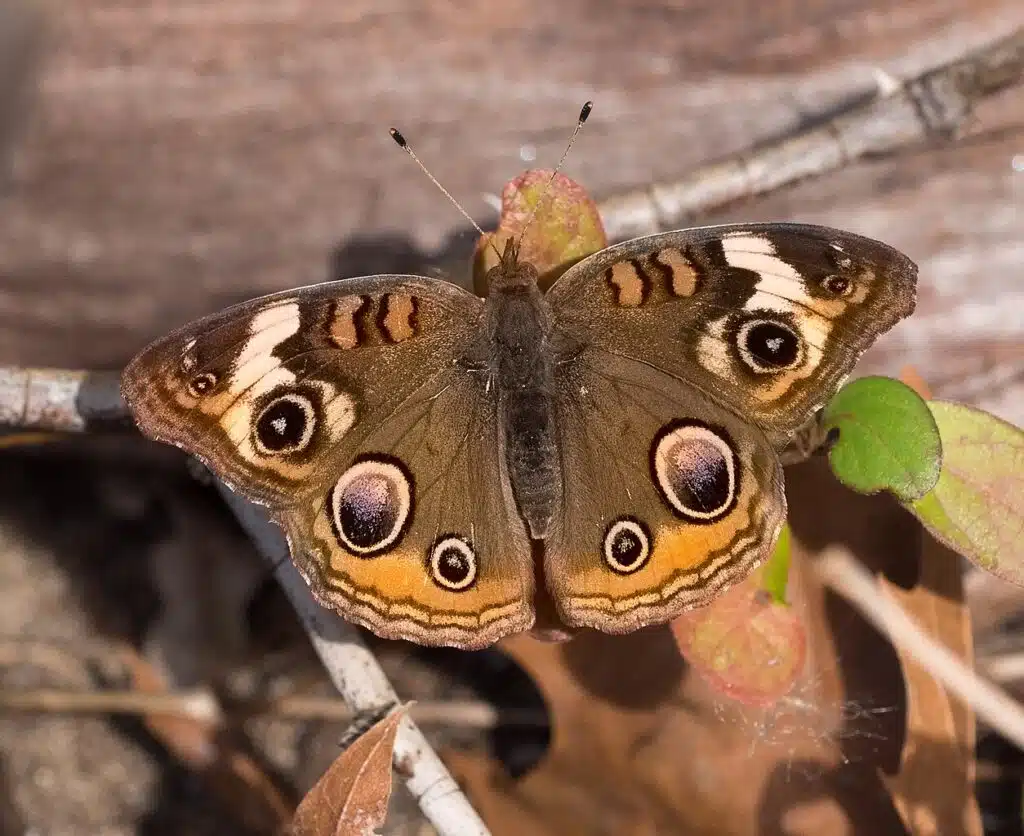
Common Buckeye butterflies (Junonia coenia) are known for having large eyespots on the dorsal wings.
The species has brown coloring that dominates the forewings and the upper part of the hindwings.
These butterflies are also known for being one of the migratory species in the state.
They move to Southern states in the winter reaching even habitats in California to escape cold winters in the North.
36. Dun Skipper
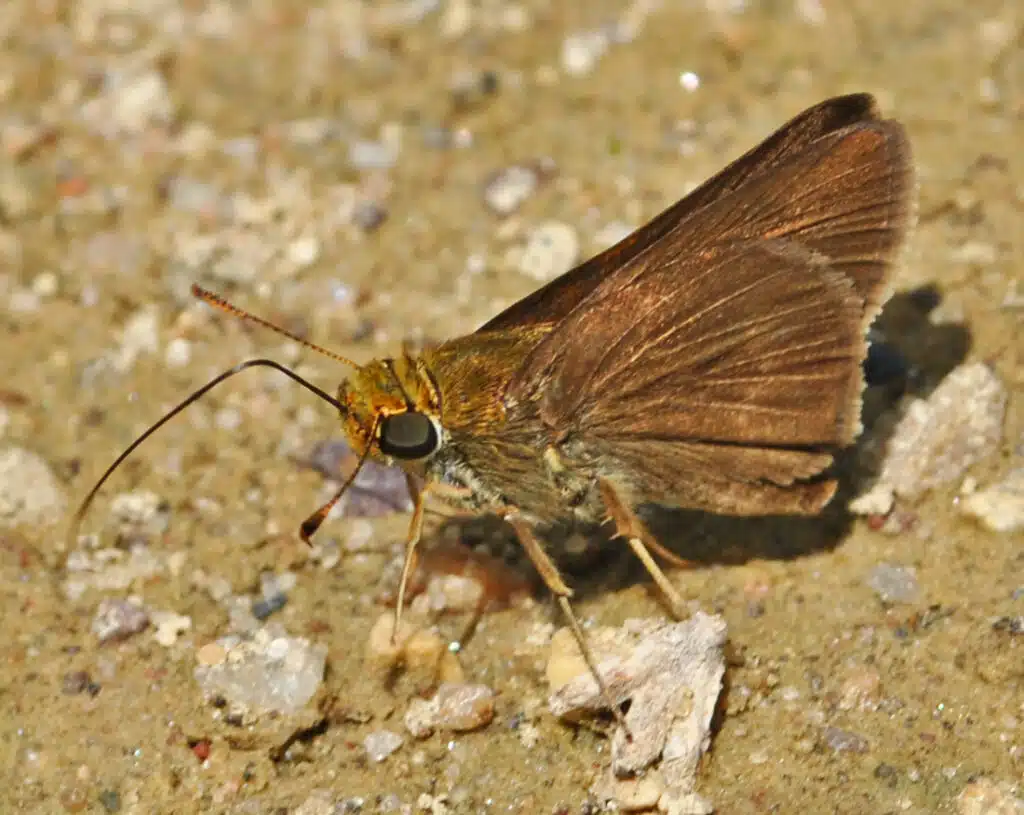
Dun Skippers (Euphyes vestris) are small butterflies with a wingspan of up to 35mm.
They have dark brown wings and light brown spots on the forewings.
Purple vetch and peppermint are among the most common plants used as food sources by the species. Mountain sweet is a type of plant Dun Skippers also feeds on at higher altitudes.
Dun Skipper caterpillars only feed on sedges.
37. Common Ringlet
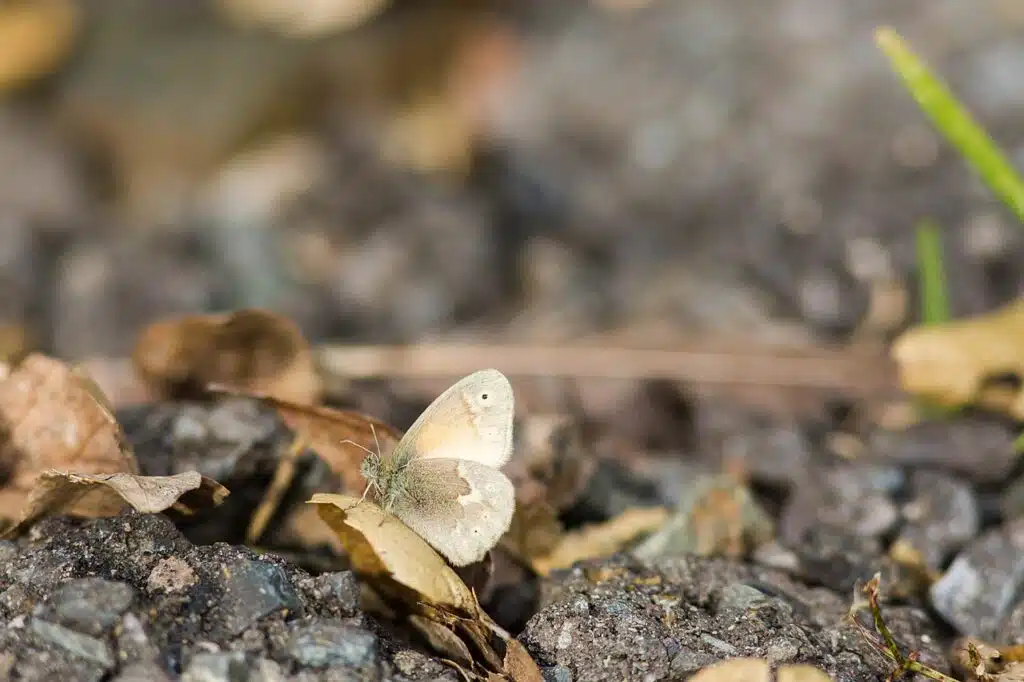
Common Ringlet butterflies (Coenonympha california) are small species with white or off-white coloring.
The species has gray and tan areas across its ventral wings
Some of the smallest black eyespots are also seen across the ventral areas of its wings.
This species flies just inches above the ground, typically in grassy areas.
38. Orange Sulphur
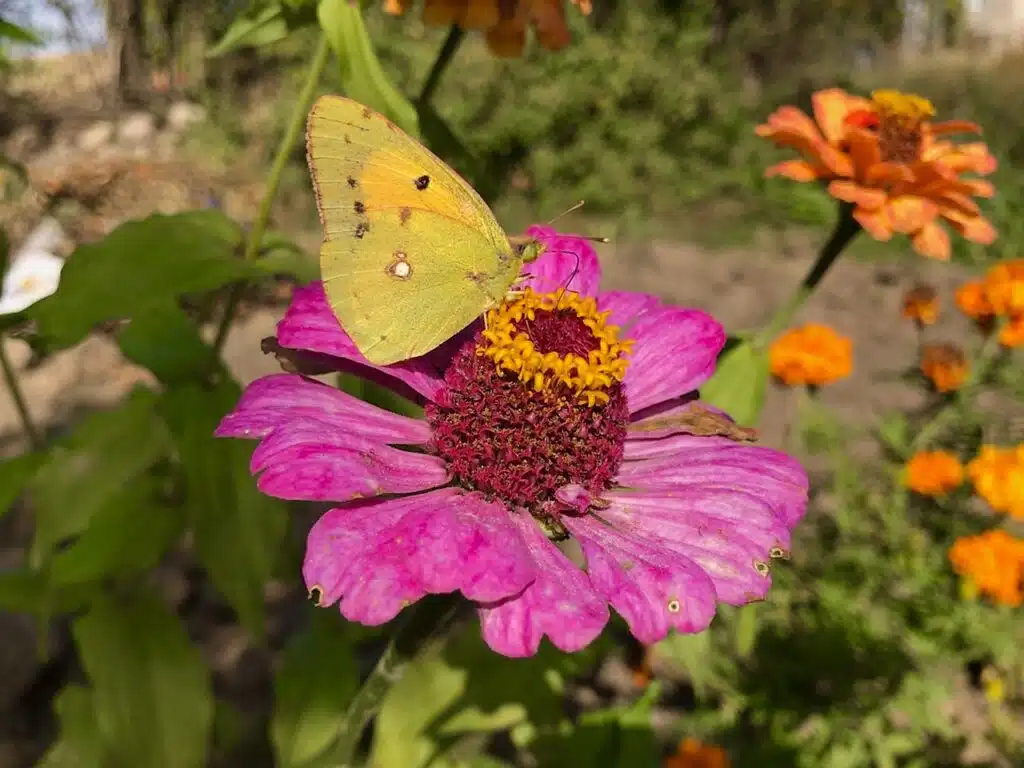
This orange butterfly (Colias eurytheme) can quickly become a serious pest, particularly on alfalfa.
Its caterpillars are nocturnal and may not be immediately noticed until they start to eat legumes.
Outside of crops, Orange Sulphur caterpillars can become an issue for pea family plants.
This species is sometimes referred to as The Alfalfa Butterly.
39. Summer Azure
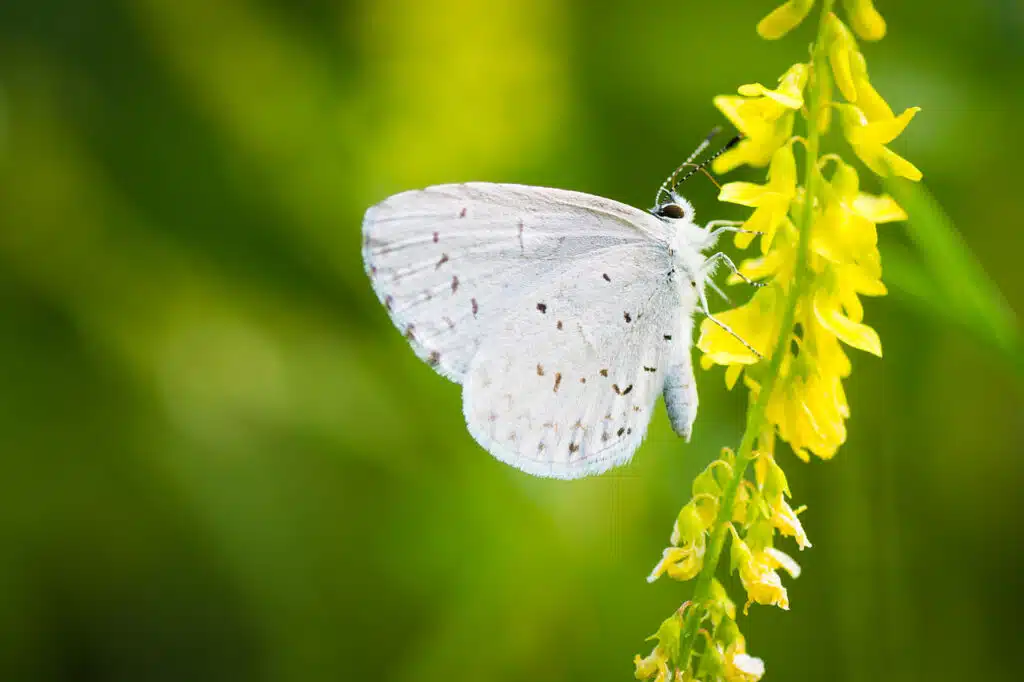
Areas with dogwood are among the most common habitats for Summer Azures (Celastrina neglecta). Caterpillars of the species rely on these plants for food.
Adults move on to other areas looking for plant nectar.
With a wingspan of just over 1 inch, these butterflies can be seen feeding together until a group or an area starts to become overcrowded.
40. Northern Azure
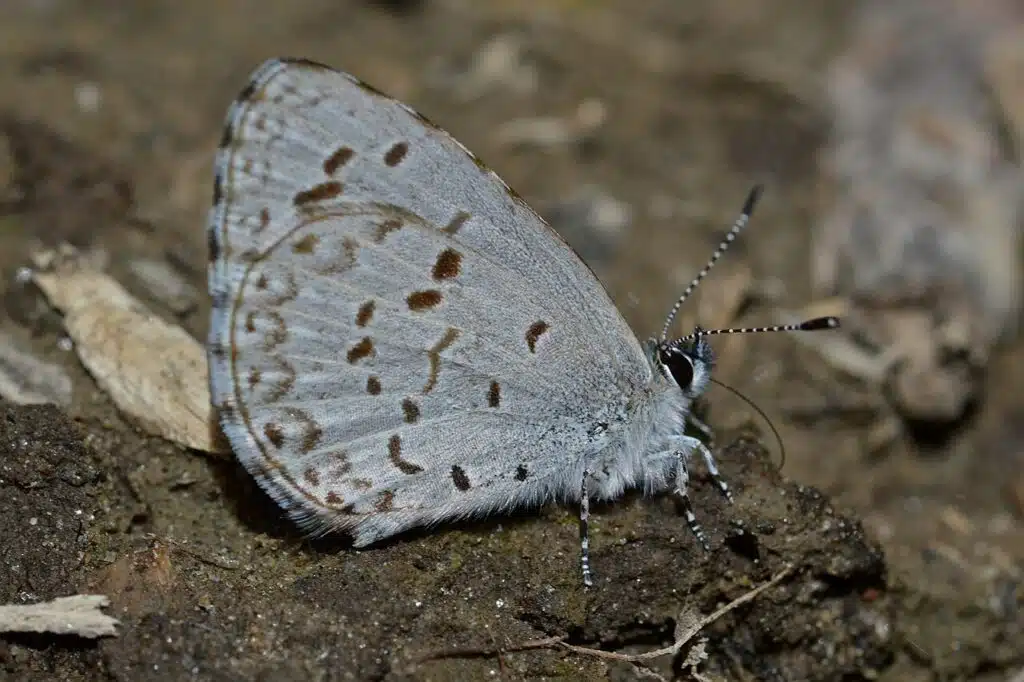
Similar to Summer Azures, Northern Azures (Celastrina lucia) have bright blue coloring across the dorsal area of the wings.
These butterflies also have narrower black margins across the wings, unlike the wide black margins of Summer Azures.
You can find these butterflies and their caterpillars in areas that are rich in blueberries, hillside blueberries, and cranberries.